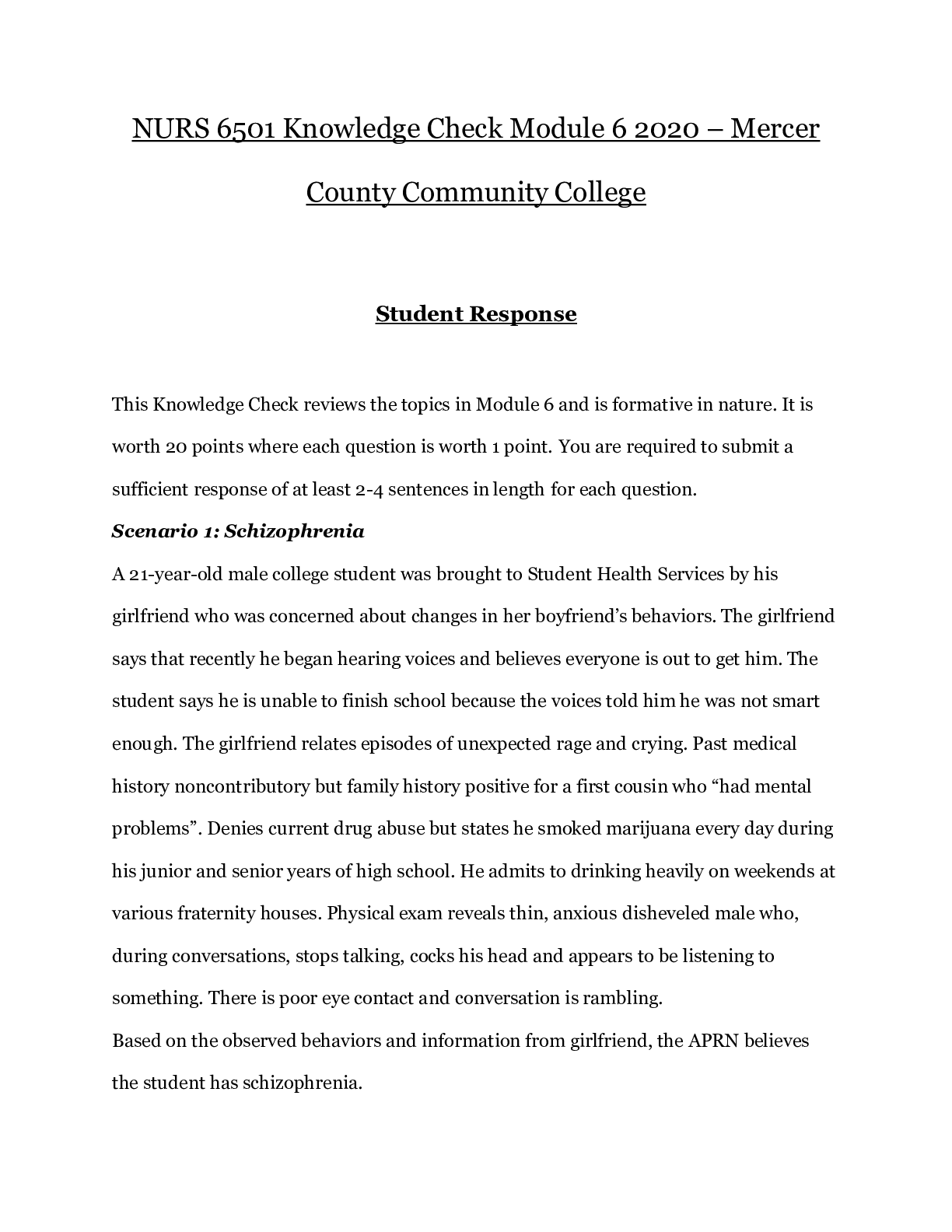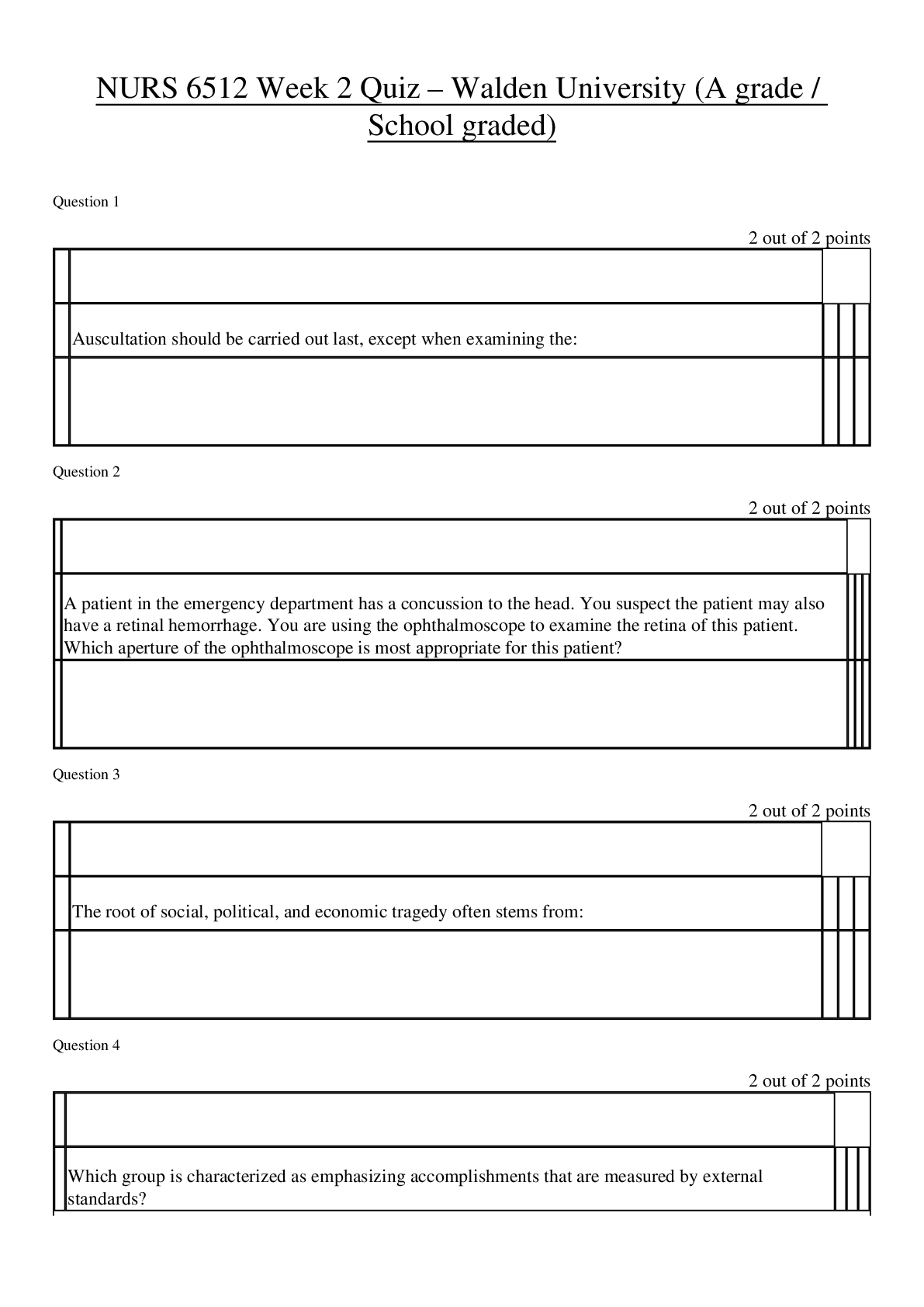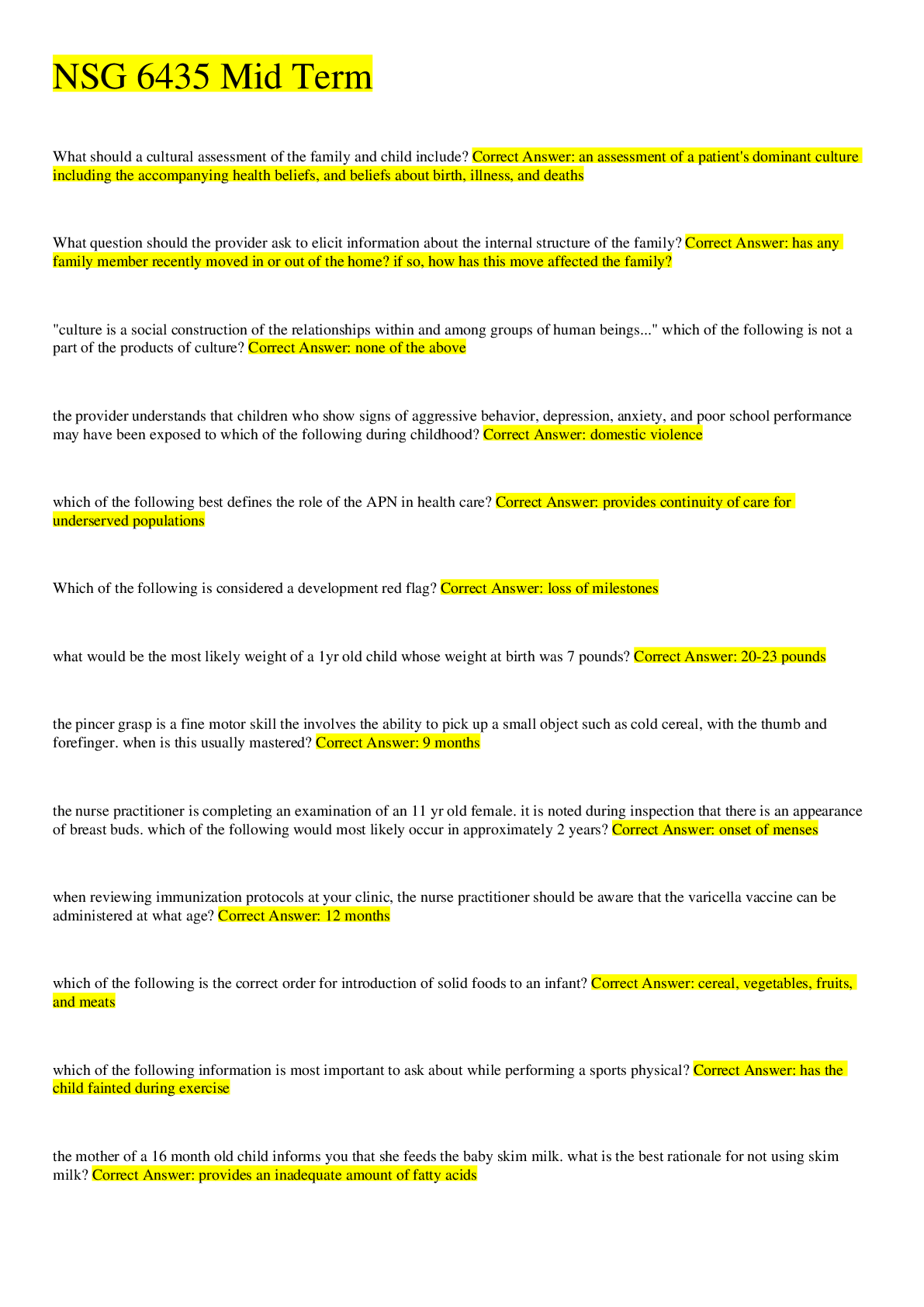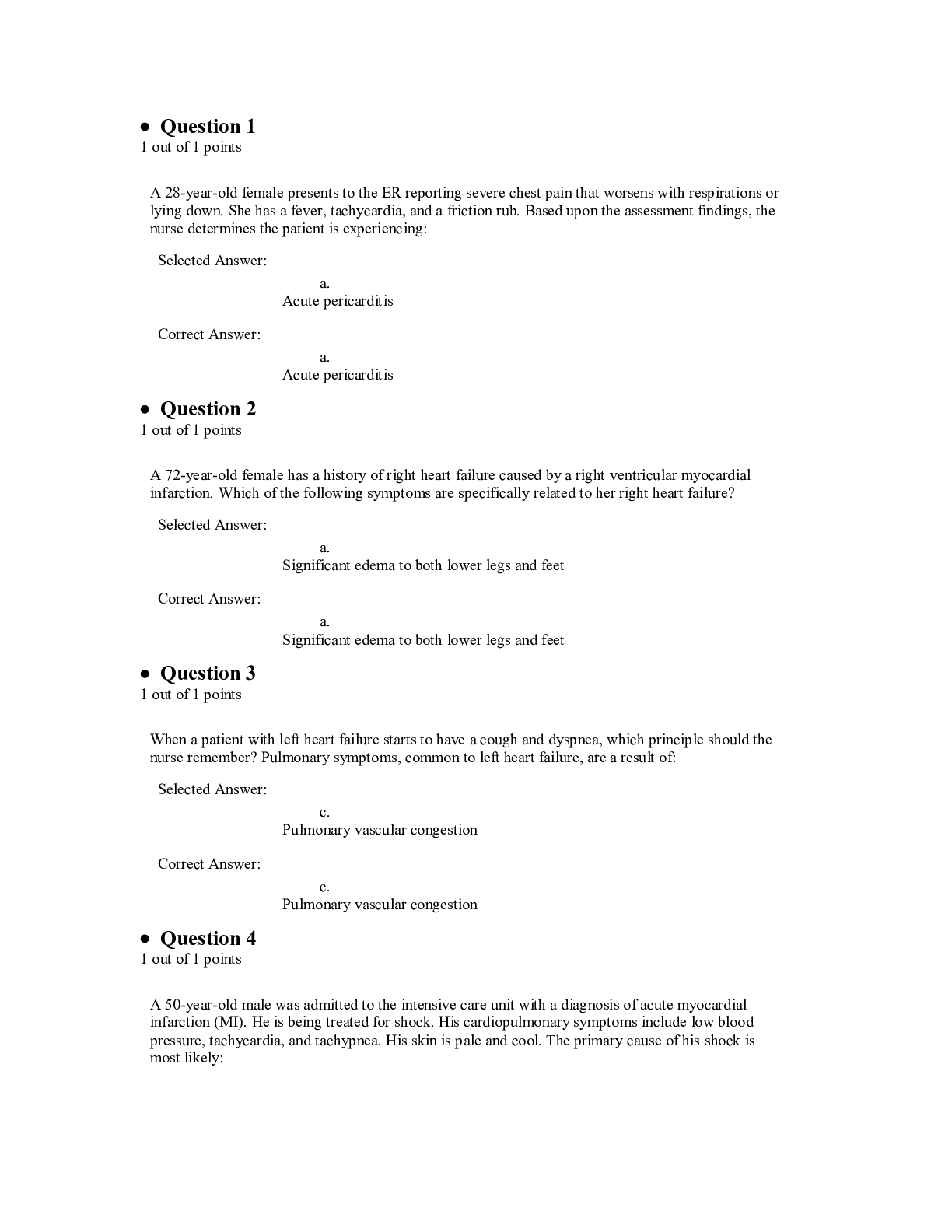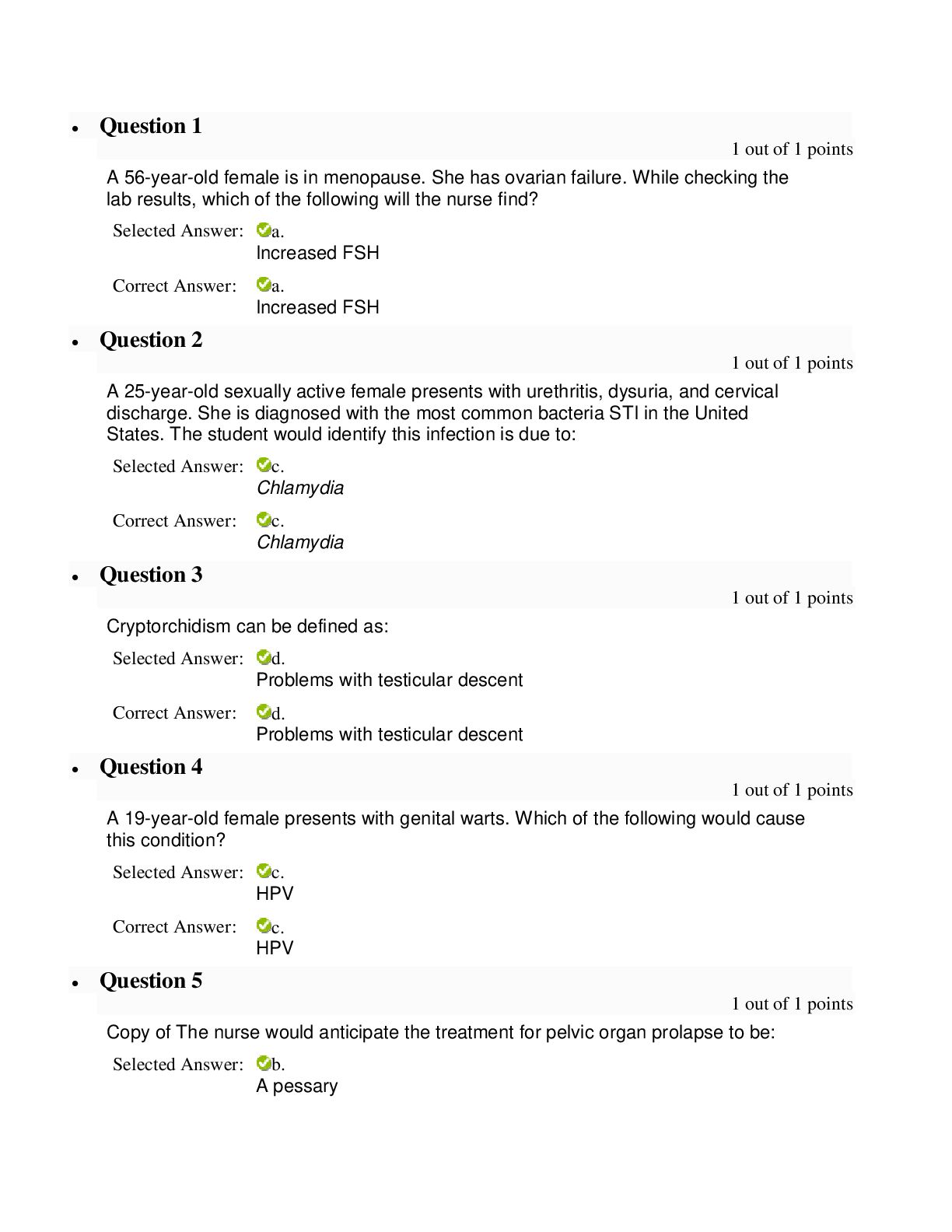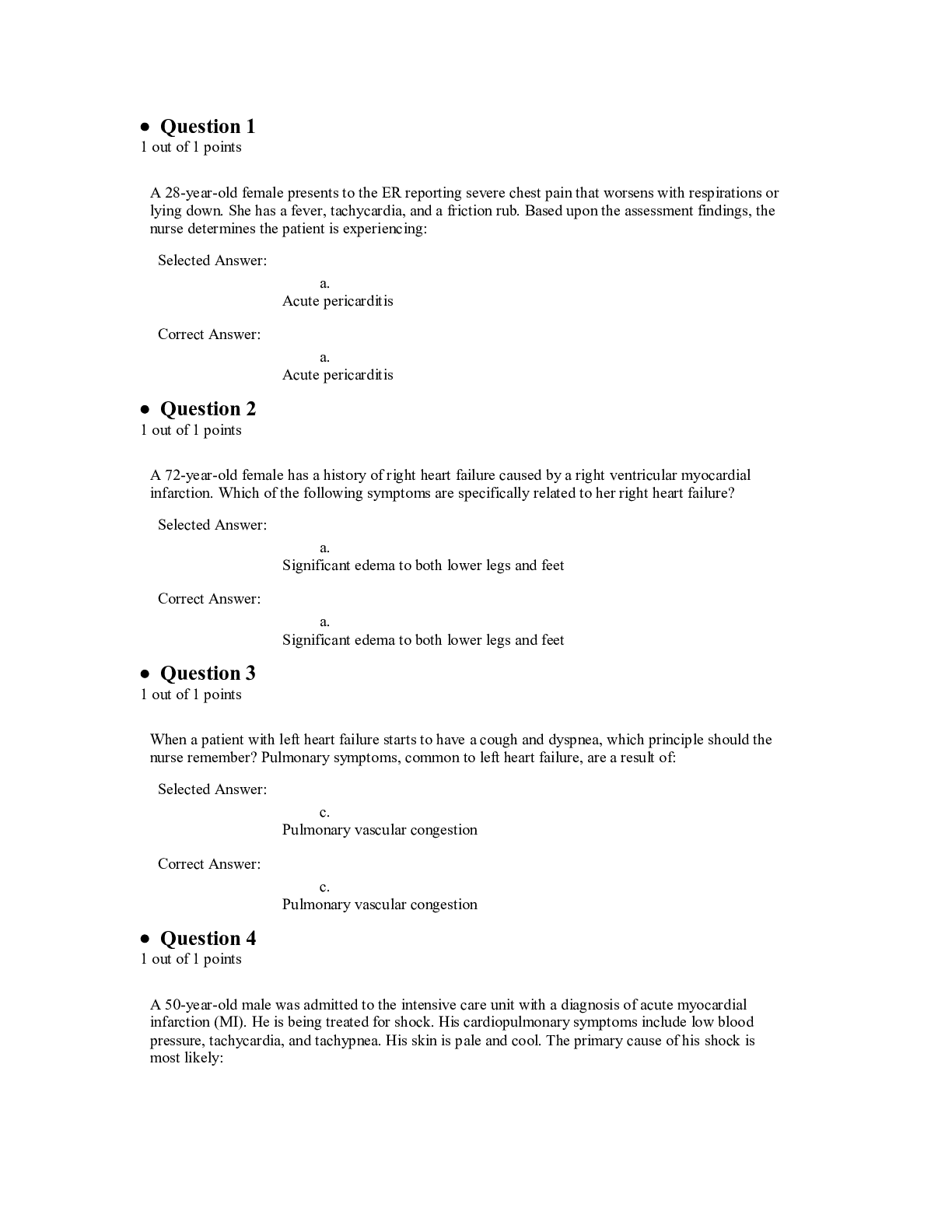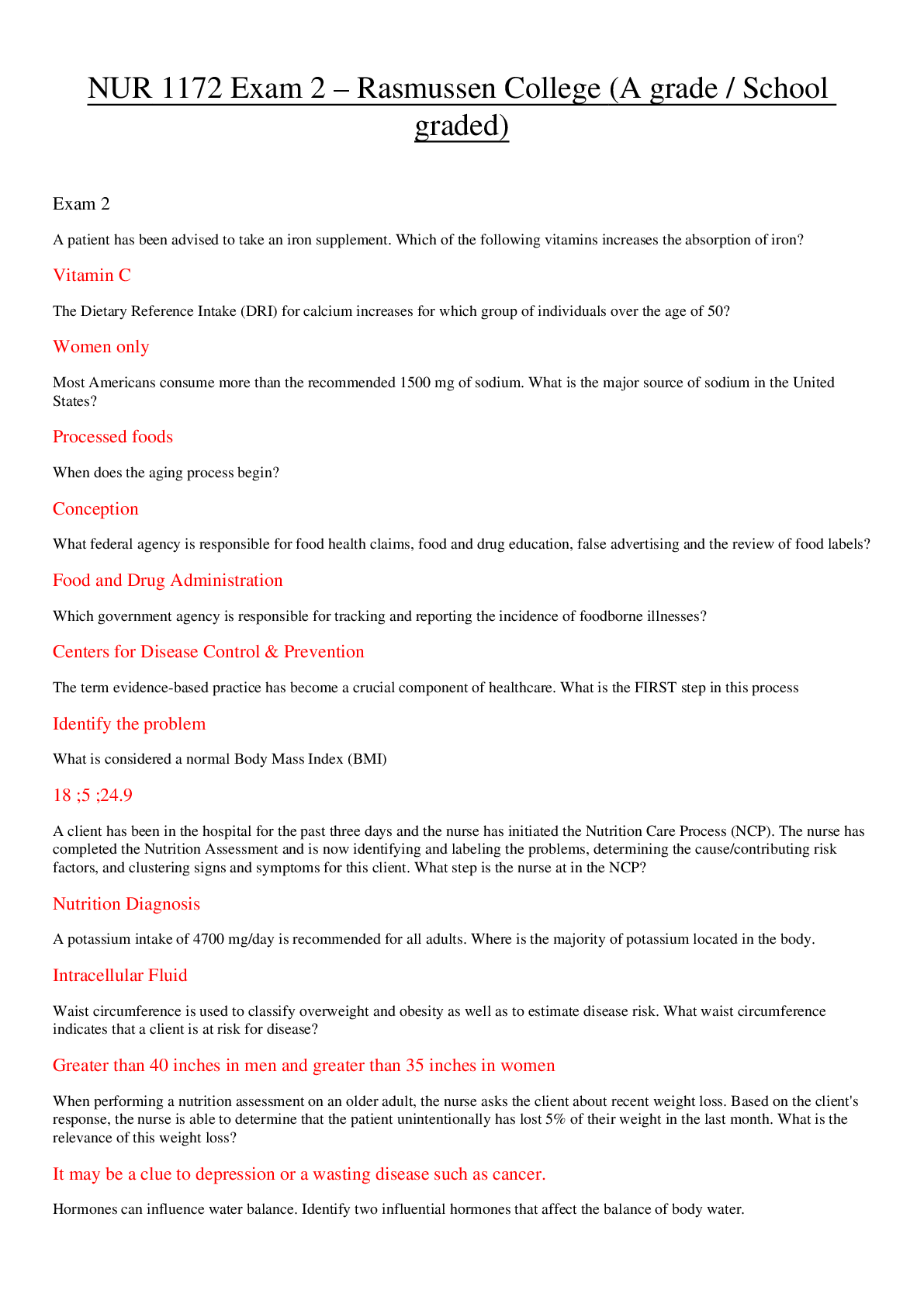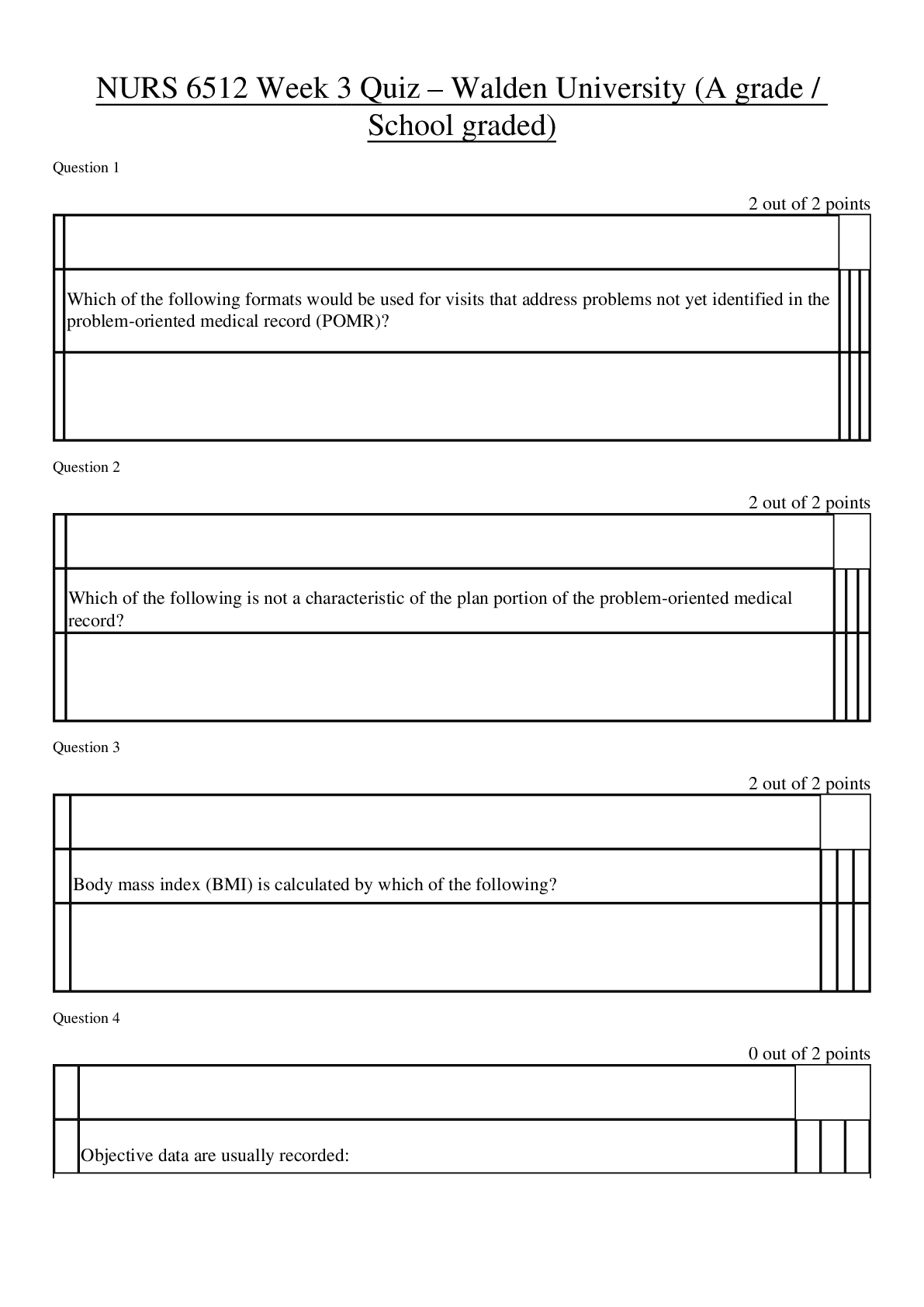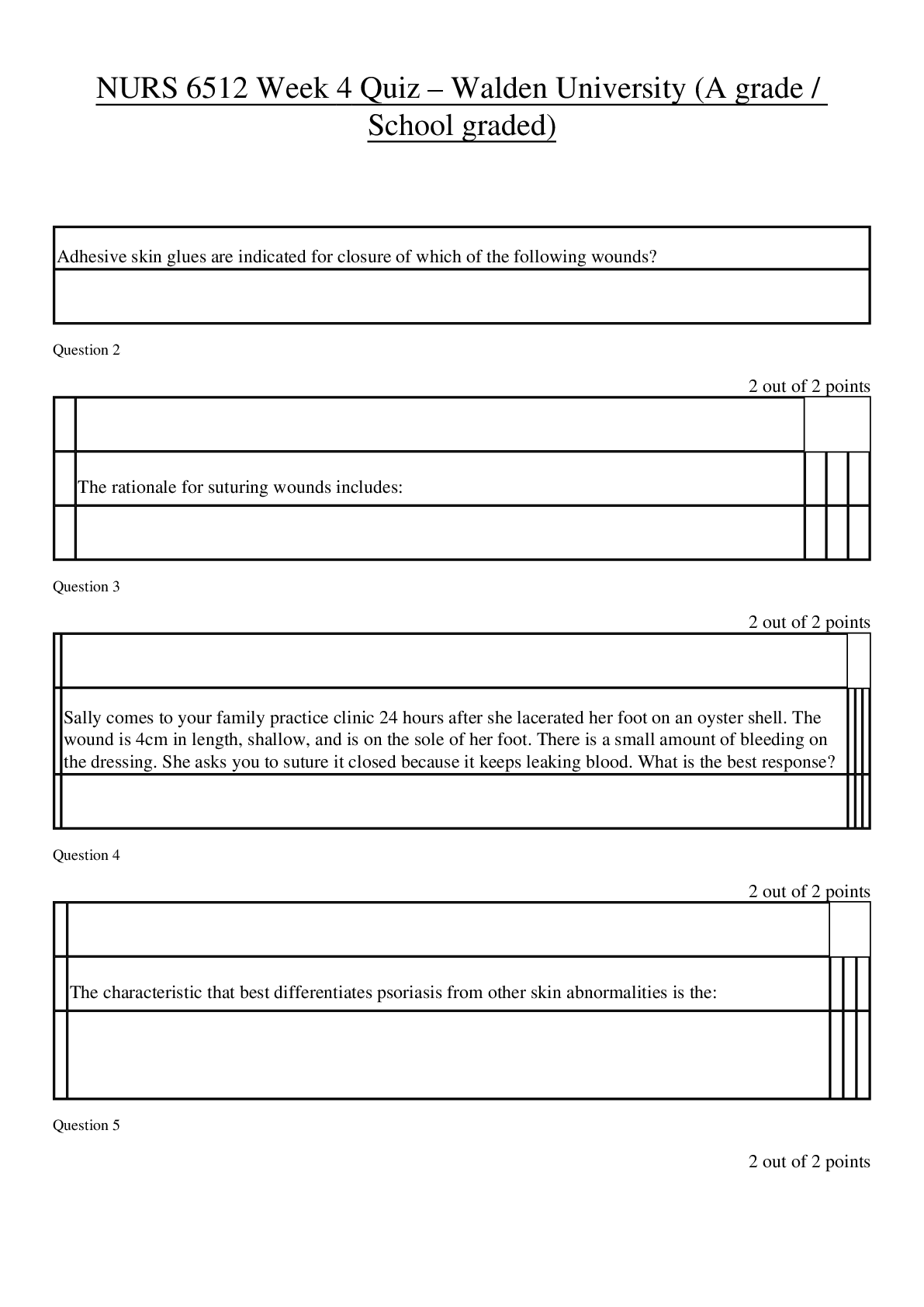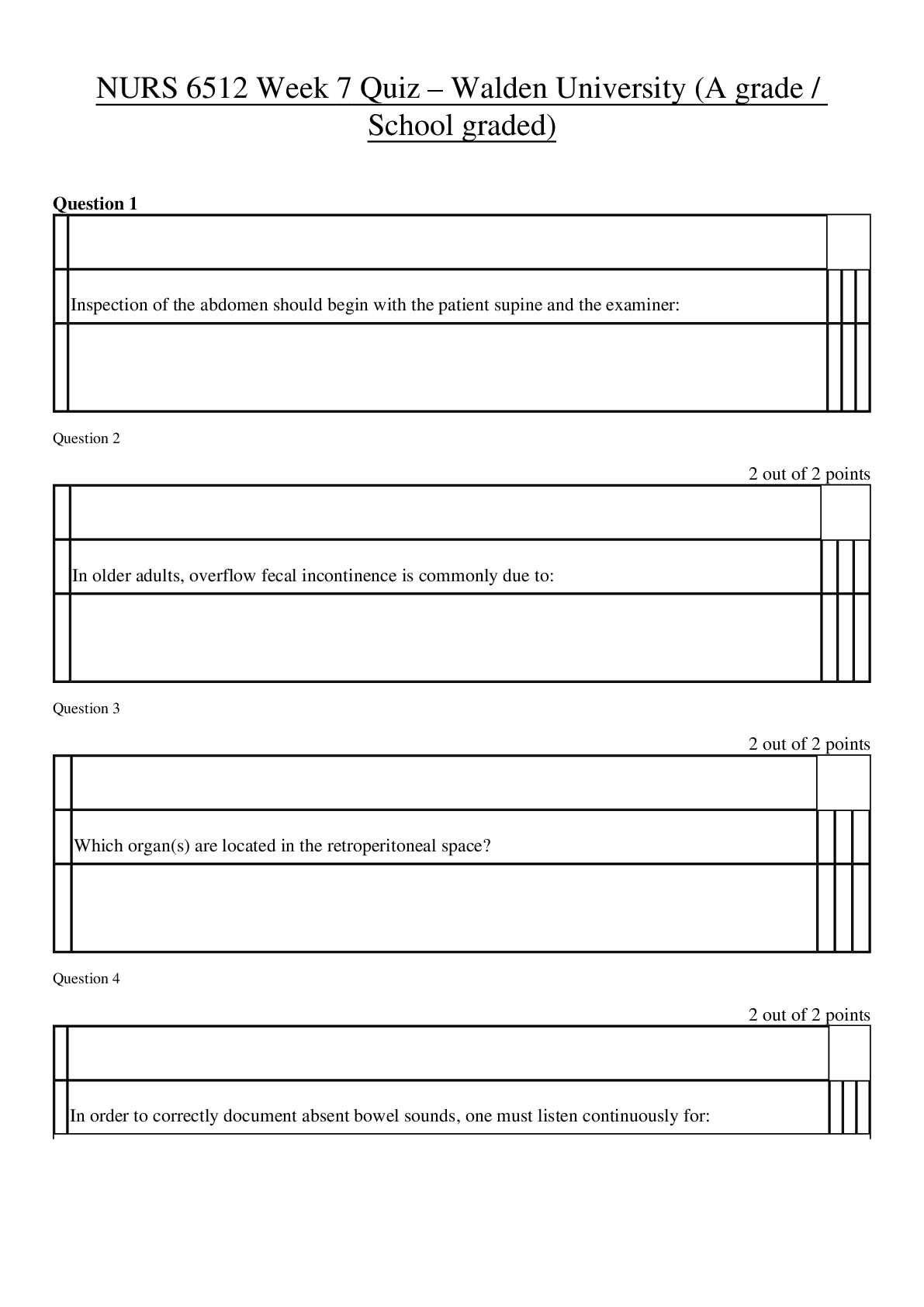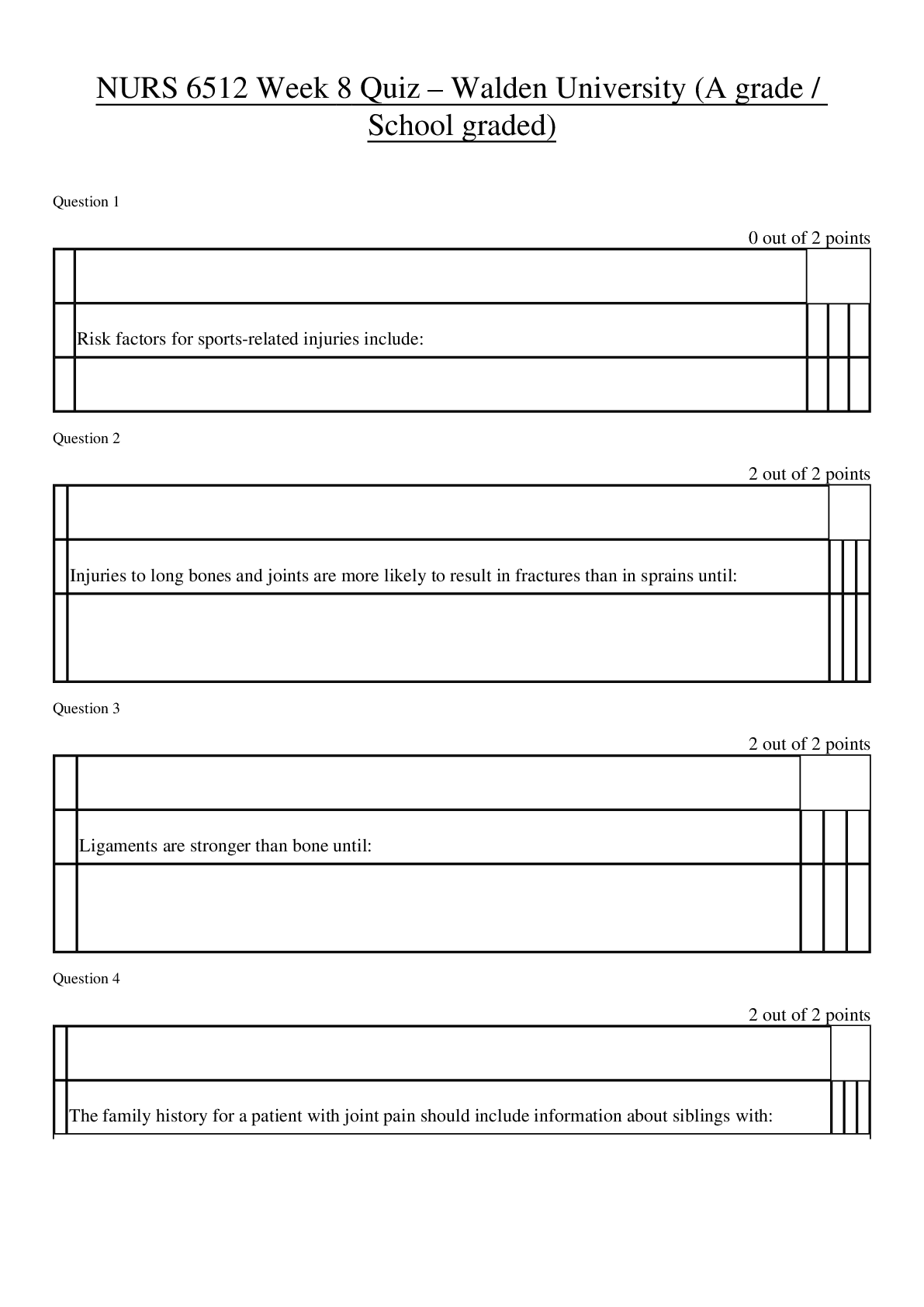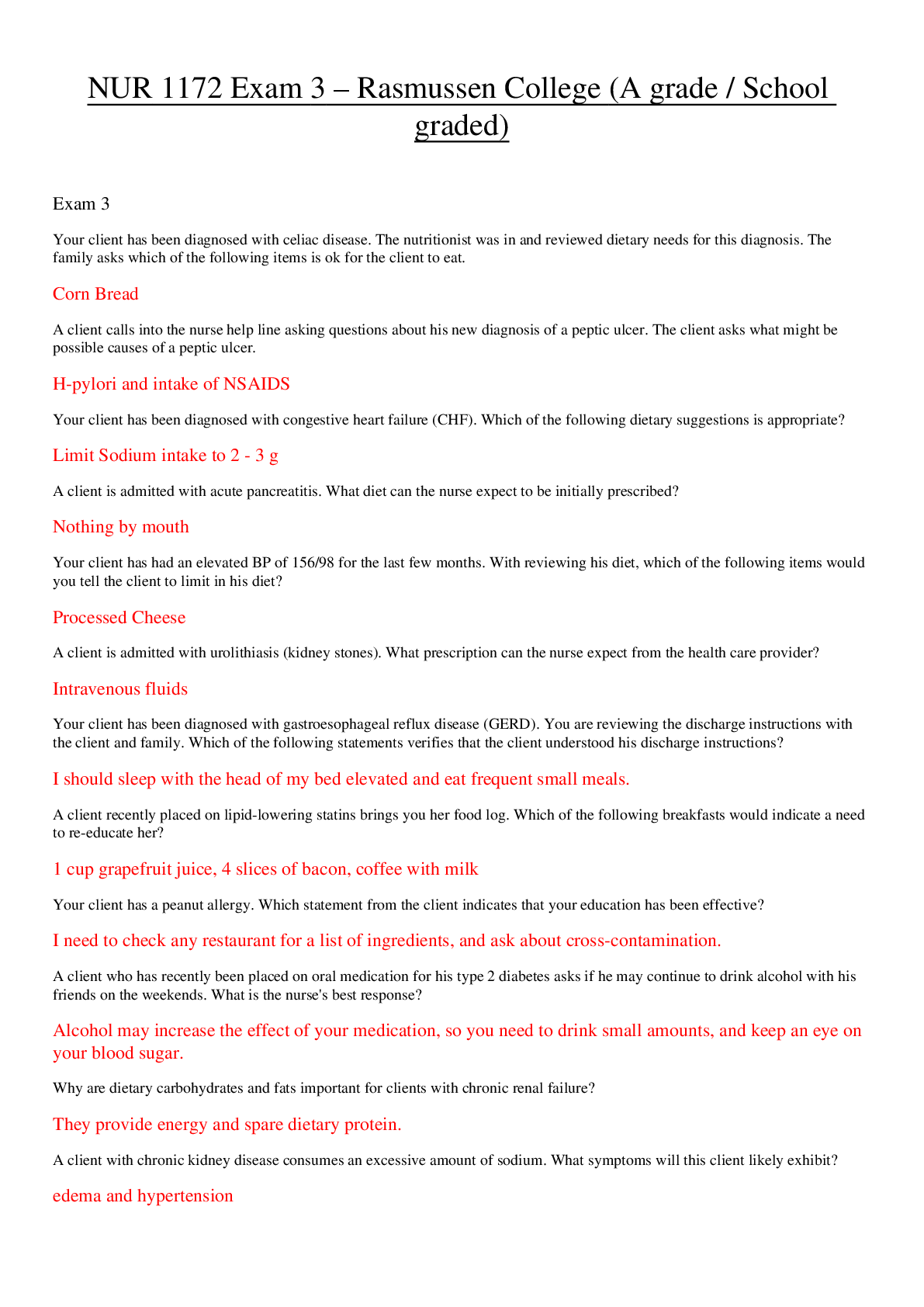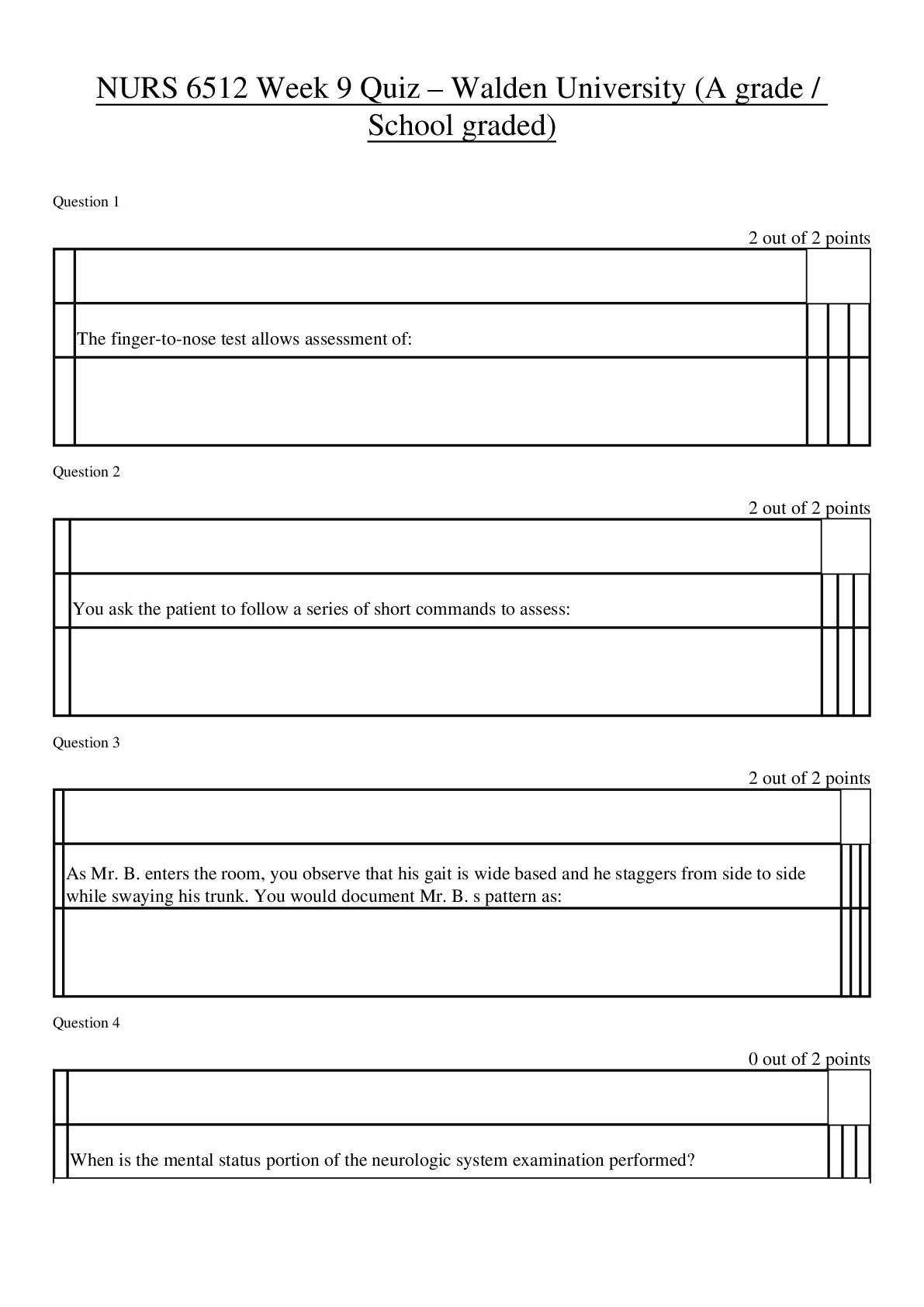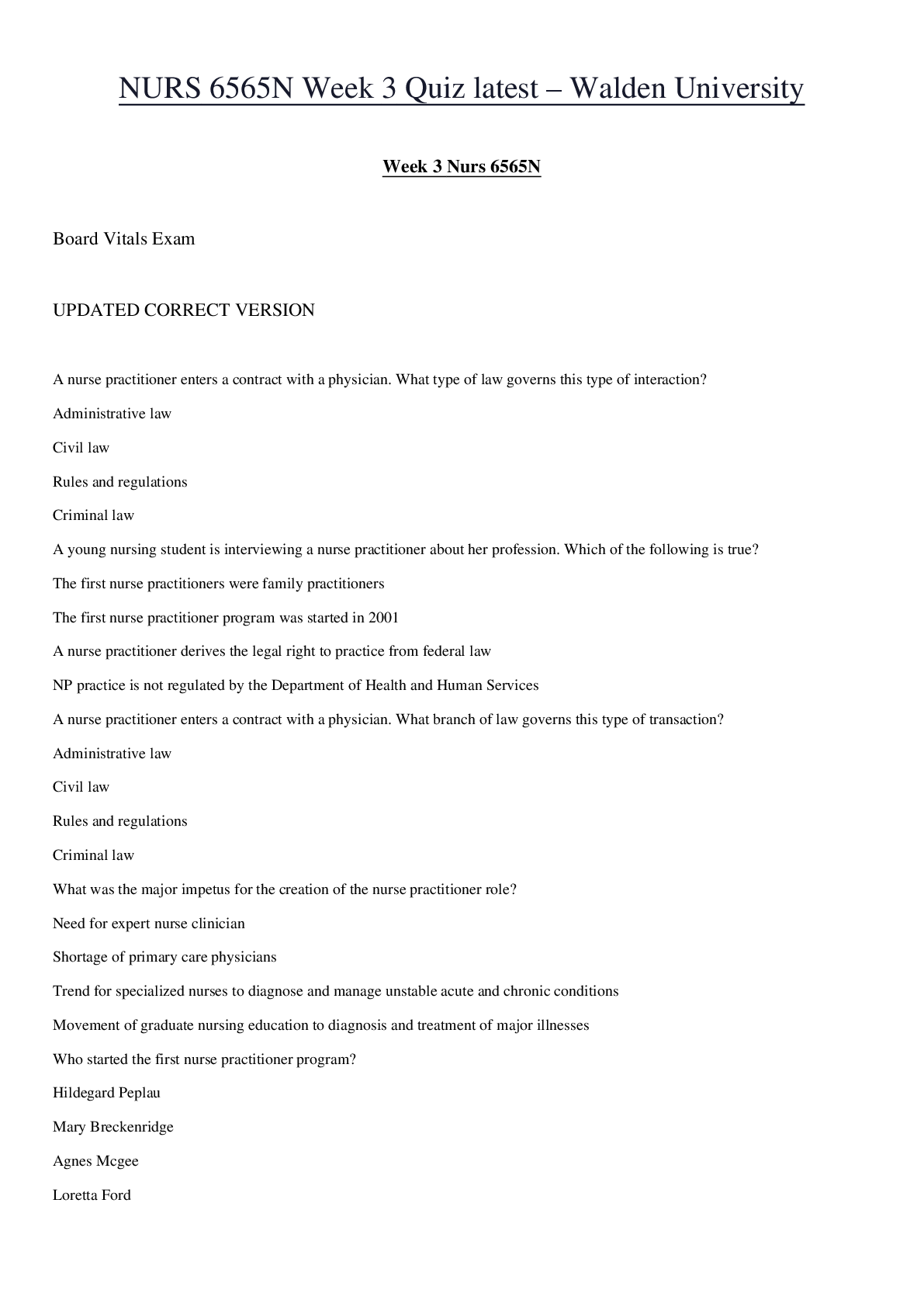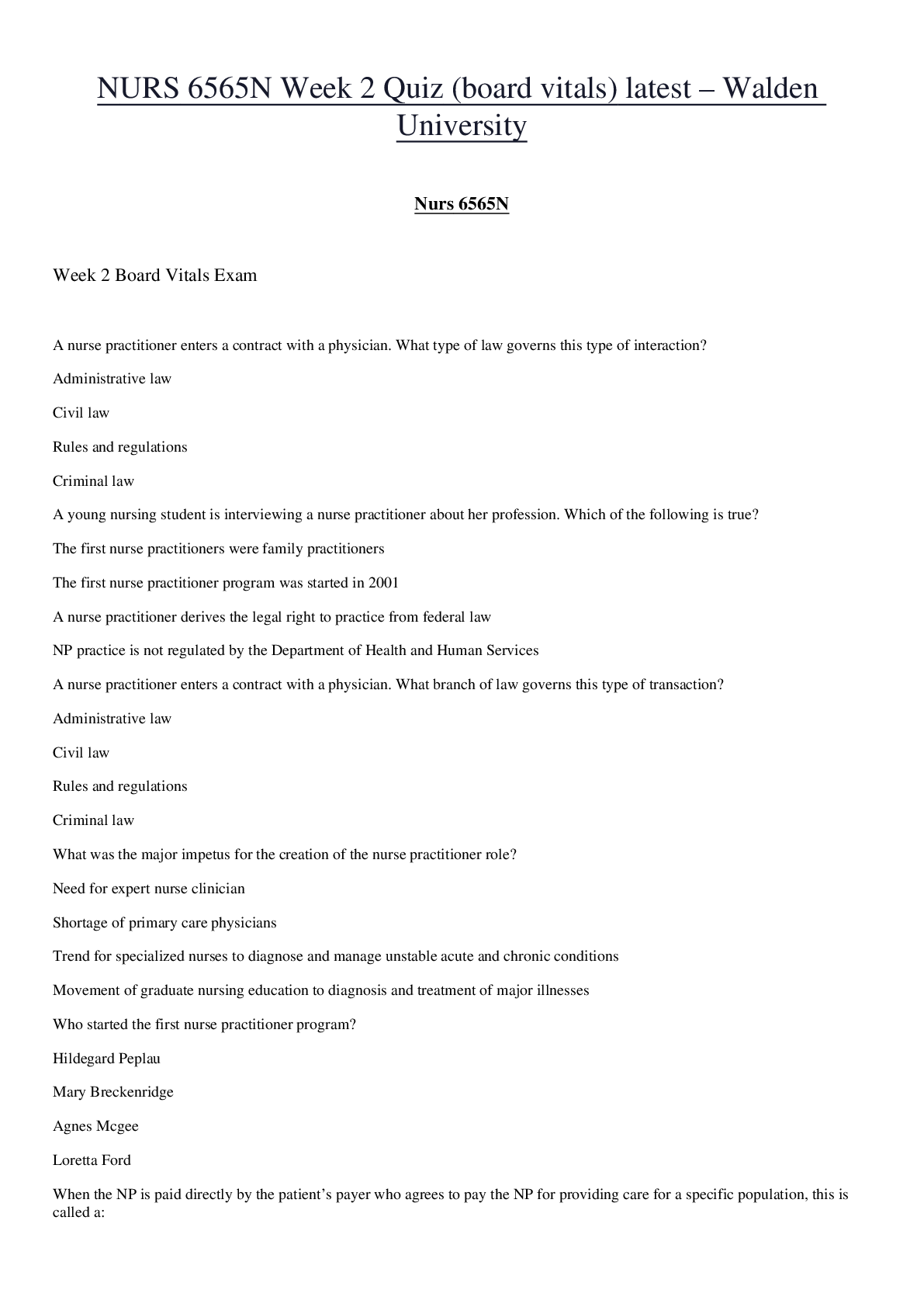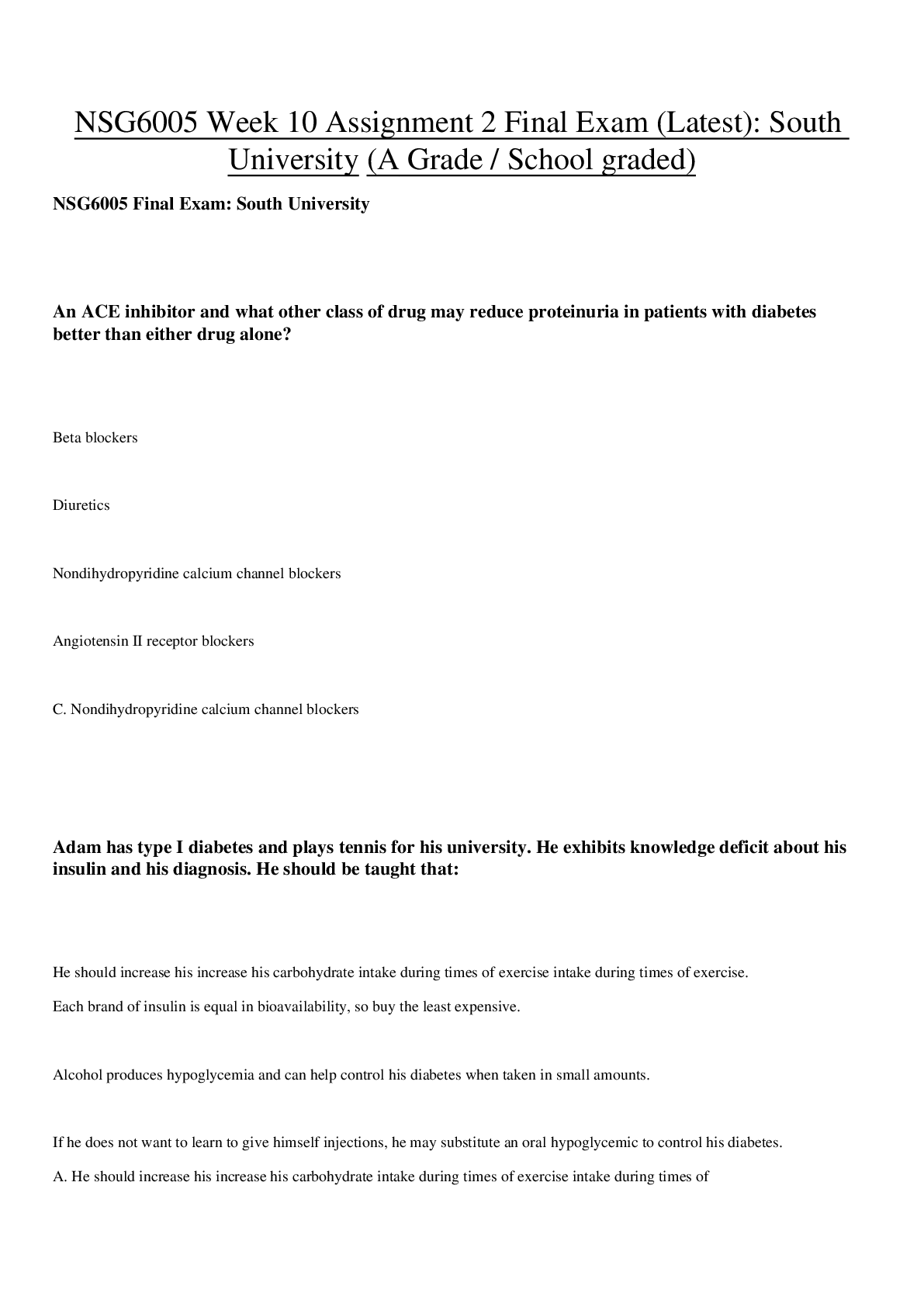*NURSING > EXAM > NURS 6541 pediatrics midterm exam – Walden University ( A grade / School graded) (All)
NURS 6541 pediatrics midterm exam – Walden University ( A grade / School graded)
Document Content and Description Below
NURS 6541 pediatrics midterm exam – Walden University ( A grade / School graded) Question 1 0 out of 1 points Medicaid provides health insurance coverage to Ques... tion 2 1 out of 1 points A differential diagnosis for child abuse would include all of the following except. Question 3 1 out of 1 points Which of the following injuries is most likely to be caused by abuse of a toddler? Question 4 1 out of 1 points You are doing a kindergarten physical on a 5-year-old girl. Which of the following scenarios would suggest the child is not ready to start kindergarten in the fall? Question 5 1 out of 1 points The first sign of the onset of female puberty is usually: Question 6 1 out of 1 points You see a 7-year-old with complaints of "having accidents at night." Physical exam and history are unremarkable. Urinalysis, urine culture, and specific gravity are normal. His parents ask about the best treatment for this problem. The best response is Question 7 1 out of 1 points Which of the following statements about bullying is true? Question 8 0 out of 1 points The mother of a 5-year-old informs you that her daughter cheats when playing board games. What is the best response? Question 9 0 out of 1 points Which of the following conditions requires urgent inpatient admission? Question 10 1 out of 1 points All of the following are consistent with peritonsillar abscess except: Question 11 1 out of 1 points The parents of a 7-year-old are concerned their son does not want to attend school. Which of the historical findings are not usually associated with the diagnosis of school phobia? Question 12 0 out of 1 points You are performing an examination of a 3-year-old who is new to your office. Which finding requires immediate further evaluation? Question 13 1 out of 1 points A child's head circumference is routinely measured on each well visit until what age? Question 14 1 out of 1 points Which of the following children has abnormal language development? Question 15 1 out of 1 points Please interpret the following labs for an adolescent. The adolescent has a history of obesity and acanthosis nigricans. Test Results Fasting blood glucose 112 mg/dL 2 hour postprandial glucose 138 mg/dL Question 16 1 out of 1 points Which of the following issues or concepts is relevant to the school-age child? Question 17 1 out of 1 points The diagnostic criteria for autism spectrum disorder include all of the following except Question 18 1 out of 1 points Conductive hearing loss can be caused by Question 19 1 out of 1 points The most common substance used in middle school is Question 20 0 out of 1 points The results of the hemoglobin A1c test are LESS reliable in children with which of the following conditions? (Hint: select two) Question 21 1 out of 1 points A teenage female who is overweight has moderate acne on the face and chest, and irregular menses. Elevation of which laboratory test provides the test evidence of polycystic ovarian syndrome? Question 22 1 out of 1 points Mark is in the exam room. You are concerned he may have epiglottitis. In what position do these patients prefer to sit? Question 23 1 out of 1 points You see a 30-month-old who speaks in mixed Spanish and English. The child’s vocabulary is normal but at the low end of the normal language spectrum. The parent is worried the child’s development will not be normal because she mixes up the two languages. You respond: Question 24 1 out of 1 points Which of the following characterizes middle adolescence (14 to 16 years old)? b. Intense peer group involvement, feelings of immortality, sexual experimentation Question 25 1 out of 1 points You see a 4-year-old for a well-child visit. He has received four diphtheria, tetanus, and acellular pertussis vaccines (DTaP); three injected polio vaccines (IPV); one measles, mumps, and rubella vaccine (MMR); one varicella vaccine; and two hepatitis B (Hep B) vaccines. What do you order today? c. DTaP, IPV, MMR, and Varivax Question 26 1 out of 1 points A 14-year old has ataxia. He is brought to the local emergency department, where he appears euphoric, emotionally labile, and a bit disoriented. He has nystagmus and hypersalivation. Many notice his abusive language. Which of the following agents is most likely responsible for his condition? d. Alcohol Question 27 1 out of 1 points Parents bring their 6-month-old son to see you. He is symmetrically less than the 5th percentile for height, weight and head circumference. He was born at 30 weeks’ gestation and weighed 1000g. He was a planned pregnancy, and his mother’s prenatal course was uneventful until an automobile accident initiated the labor. He was ventilated for 3 days in the intensive care unit but otherwise did well without ongoing problems. He was discharged at 8 weeks of life. Which of the following is the most likely explanation for his small size? b. Normal ex-preemie infant growth Question 28 1 out of 1 points A fifteen-year-old female makes a statement to you during a well visit. Which of the following statements should not be kept confidential? c. "Sometimes I feel like ending my life." Question 29 1 out of 1 points Most children can independently get dressed by themselves by age: b. 5 years Question 30 0 out of 1 points A 13-month-old child is noted to be at the 25th percentile for weight, the 10th percentile for height, and less than the 5th percentile for head circumference. She was born at term. She was noted to have a small head at birth, to be developmentally delayed throughout her life, and to have required cataract surgery shortly after birth. She currently takes phenobarbital for seizures. Which of the following would most likely explain this child’s small size? b. Down syndrome Question 31 1 out of 1 points A 4-month-old child has poor weight gain. Her current weight is less than the 5th percentile, height about the 10th percentile, and head circumference at the 50th percentile. The planned pregnancy resulted in a normal, spontaneous, vaginal delivery; mother and child were discharged after a 48-hour hospitalization. Feeding is via breast and bottle; the quantity seems sufficient. The child has had no illness. The examination is unremarkable except for the child’s small size. Screening laboratory shows the hemoglobin and hematocrit are 11 mg/dL and 33% respectively, with a platelet count of 198,000/mm3. Serum electrolyte levels are sodium 140, chloride 105, potassium 3.5, bicarbonate 17, blood urea nitrogen 15, and creatinine 0.3. Liver function tests are normal. Urinalysis reveals a pH of 8 with occasional epithelial cells but no white blood cells, bacteria, protein, ketones, or reducing substances. Which of the following is the most appropriate therapy for this child? d. Oral supplementation with bicarbonate Question 32 1 out of 1 points Chelsea, age 8, complains that she feels as if something is stuck in her ear. What action is contraindicated? b. Flushing the ear with water. Question 33 1 out of 1 points Which of the following substances is associated with pupillary constriction? c. Heroin Question 34 0 out of 1 points Which of the following children should be referred for a comprehensive developmental evaluation? a. A 12-month-old who does not speak. Question 35 0 out of 1 points John is diagnosed with allergic conjunctivitis. What type of discharge do you expect to see upon exam? a. Purulent Question 36 1 out of 1 points You diagnose a 16-year-old with acute otitis media and need to prescribe an antibiotic with beta-lactamase coverage. What do you choose? d. amoxicillin and potassium clavulanate (Augmentin) Question 37 1 out of 1 points A new mom calls the NP on postpartum day 5. She reports her newborn wants to nurse for 30 minutes every 1-1/2 to 2 hours. Which of these is the best response? d. "This is a very healthy breastfeeding pattern. Be sure to rest when you can. You are doing a great job." Question 38 1 out of 1 points Which of the following represents normal sequencing of development in a toddler? b. Feeds self, can undress self with help, washes hands, imitates housework. Question 39 1 out of 1 points By what age should most children be able to sit well without support? a. 9 months Question 40 0 out of 1 points A common feature of 2-year-old behavior is: d. a and b Question 41 1 out of 1 points You assess a 15-year-old's visual acuity and note her vision to be 20/50 in the right eye. She asks you what that means and you respond d. "You can see at 20 feet with your right eye what most people can see at 50 feet." Question 42 1 out of 1 points Flourescein staining of the eye is used to detect a b. Corneal abrasion Question 43 1 out of 1 points Blood pressure should be measured at well-child visits starting at age: a. 3 years Question 44 1 out of 1 points Sarah, 7 years old, is in the office today. All of the following are acceptable management options for allergic rhinitis, except a. Nasal neosynephrine Question 45 0 out of 1 points During a “well-child” visit, the parents of a healthy 5-month-old offer a great amount of information. Which of the following bits of information is of most concern? e. Intermittent tugging on the ears. Question 46 0 out of 1 points At what age would a child be expected to remember a string of numbers and repeat them backwards? a. 6 years Question 47 1 out of 1 points During a domestic health assessment, the CDC recommends screening every refugee child for which of the following diseases? b. tuberculosis Question 48 1 out of 1 points Which of the following signs may indicate a baby is not receiving sufficient breastmilk? a. Sleepiness, jaundice, and vomiting Question 49 1 out of 1 points Which of the following eye findings would be considered an ophthalmic emergency? d. Unilateral vesicular lesions on the upper eyelid in a 3-week old. Question 50 1 out of 1 points Which of the following statements regarding adolescent substance use is true? c. Tobacco is the most commonly abused substance during adolescence. Question 51 1 out of 1 points Which of the following vaccines is routinely recommended at 4 months of age? a. Diphtheria, tetanus, acellular pertussis (DTaP) Question 52 1 out of 1 points The nurse practitioner role was initially established to c. Improve access to care and partially solve physician shortage. Question 53 1 out of 1 points Mark, a 10-year-old, has a lot of ear pain. He does not want anyone to touch it and is crying in pain. The ear canal is swollen and exudate is present. The TM is normal. Mark should be instructed to do which of the following? b. Keep ear dry until symptoms improve. Question 54 0 out of 1 points A 4-year-old believes there is more juice in a tall, thin glass than a shorter, wider one. The child has not yet achieved which of the principles of Piaget? c. Abstract reasoning Question 55 0 out of 1 points Early reflexive responses that are not related to survival include all but: a. Swimming Question 56 0 out of 1 points You would be concerned about the language development of a child who: d. Repeats simple phrases at 32 months Question 57 0 out of 1 points The appropriate lab tests in assessment of cervical adenitis include all of the following except: c. PPD Question 58 1 out of 1 points A 4-month-old presents with both eyes turning inward. What is this called? c. Esotropia Question 59 0 out of 1 points An 8-year-old female is brought into the office by her mother. She has complaints of fever and sore throat for the past 2 days. She denies difficulty swallowing but has loss of appetite and mild diarrhea. A few classmates have similar symptoms. A review of systems reveals clear nasal drainage, dry cough, and hoarseness. On exam she has a 101.5 temperature, 3+ erythematous tonsils, and anterior cervical lymphadenopathy. What is the likely diagnosis? b. Strep pharyngitis Question 60 0 out of 1 points You see a 13-year-old who reports she is learning some basic geometry (areas, volume etc.). The ability to successfully master these concepts occurs during which Piaget developmental stage? a. Concrete operational Question 61 1 out of 1 points An 8-year-old female has an edematous, mildly erythematous right upper eyelid for 2 days with a fever of 102.9 (F). Which important eye assessment do you need to consider? a. Ocular mobility Question 62 1 out of 1 points Tammy, age 3, is at the office for her well-child visit. She has trouble removing her own shirt as requested. Her mother yanks off her shirt after smacking her wrist and saying, "you must do as you're told quickly." Which action is indicated? a. Observe Tammy for signs of child abuse. 1 out of 1 points A 7-year-old boy with mental retardation was born at home at 26 weeks gestation to a 28-year-old mother who had received no prenatal care. An evaluation is likely to suggest his MR is related to which of the following? a. Complications of prematurity Question 67 1 out of 1 points Which is the correct order for introduction of solid foods to an infant? d. Cereal, vegetables, fruits, and meats Question 68 1 out of 1 points Which of the following foreign body in the nose requires immediate removal? c. battery Question 69 1 out of 1 points A Mantoux test in a child with no risk factors is considered positive with a reaction of: c. at least 15 mm induration Question 70 1 out of 1 points Parents bring their 16-year-old daughter for a “well-child” checkup. She looks normal on examination. As part of your routine care you plan a urinalysis. The father pulls you aside and asks you to secretly run a UDS on his daughter. Which of the following is the most appropriate course of action? b. Explore the reasons for the request with the parents and the adolescent and perform a UDS with the adolescent's permission if the history warrants. Question 71 1 out of 1 points A 2-year-old boy has been slightly less than the 50th percentile for weight, height and head circumference, but in the last 6 months he has fallen to slightly less than the 25th percentile for weight. The pregnancy was normal, his development is as expected, and the family reports no psychosocial problems. The mother says that he is now a finicky eater (wants only macaroni and cheese at all meals), but she insists that he eat a variety of foods. The meals are marked by much frustration for everyone. His examination is normal. Which of the following is the best next step in his care? e. Reassurance and counseling for family about childhood normal developmental stage Question 72 1 out of 1 points You receive a phone call from the mother of a 2-year-old. She states her child has sleep refusal. You suggest the child should be able to: b. Set his own bedtime based on his internal clock. Question 73 0 out of 1 points All of the following may predispose a patient to thrush except: b. Age Question 74 1 out of 1 points Sarah, age 15, presents with pain and pressure over her cheeks and discolored nasal discharge. You cannot transilluminate the sinuses. You suspect which common sinus to be affected? d. Maxillary sinus Question 75 0 out of 1 points I can walk well on tiptoes, my speech is 50% understandable, I know six body parts, but I cannot balance on one foot for 1 second. I am: a. 3 years old (36 months) Question 76 1 out of 1 points Which of the following screenings should adolescents have done annually? d. Psychosocial screening, blood pressure, body mass index Question 77 0 out of 1 points A 6-month-old infant has been growing poorly. His parents have changed his formula three times without success. His examination is remarkable for a pale, emaciated child with little subcutaneous fat and anterior fontanelle fullness. His laboratory test results are notable for a hemolytic anemia and prolonged bleeding times. Which of the following is the most appropriate next step? e. Measure serum immunoglobulins Question 78 1 out of 1 points You see a 3-year-old for a well-child visit. His mother informs you that potty training has been very easy because he “has an amazing internal clock. He falls asleep, gets hungry, and has bowel movements at the same time every day.” This describes which aspect of temperament? a. Rhythmicity Question 79 1 out of 1 points A 12-year-old male states he noticed an enlargement of his testes and scrotum. When counseling him about the next step in pubertal development, you state: c. The penis will grow in length and width. Question 80 1 out of 1 points A 14-year-old female comes into the office for an urgent visit after taking 10 valium tablets. Following the initial emergent care and stailization, the most important part of the management is: c. Assessing the family supports available to the child. Question 81 0 out of 1 points A 2-year-old child weighs 34 lb. What type of car seat should the child use? a. A rear facing car seat in the back seat of the vehicle. Question 82 1 out of 1 points Which of the following is a priority nurse practitioner role to help children and adolescents to have healthy sexual development? b. Begin anticipatory guidance related to sexuality and normal pubertal development in the early school-age visits. Question 83 1 out of 1 points Epiglottitis has decreased due to which immunization? c. Hib Question 84 1 out of 1 points Role-play with equipment during the course of the physical exam would be the most beneficial with which age group? a. Preschoolers Question 85 0 out of 1 points A 2-day-old newbornwith conjunctivitis is likely due to a. Gonorrhea Question 86 1 out of 1 points A 9-year-old who weighs 70 pounds asks why she can't sit in the front passenger seat of the family car. Your best response is d. The safest place for children under 12 years old and 100 pounds is in the backseat of the car. Question 87 0 out of 1 points Which of the following would not suggest an eating disorder with a purging component? b. Finger calluses Question 88 1 out of 1 points You see a 6-month-old for a well-child visit and the mother tells you the child’s grandmother recommends that she give the infant whole milk and eggs when he starts solids. What should you tell the mother? d. The baby should remain on infant formula and stage 2 and 3 baby foods for now. Question 89 1 out of 1 points A 2-day-old infant has significant nasal and rectal bleeding. He was delivered by a midwife at home; the pregnancy was without complications. His Apgar scores were 9 at 1 minute and 9 at 5 minutes. He has breastfed well and has not required a health care professional visit since birth. Which of the following vitamin deficiencies might explain his condition? a. Vitamin K Question 90 1 out of 1 points You see a 5-month-old who is fussy, has interrupted sleep, and is drooling. You note large lower lateral incisor bulges. You recommend: e. A and D Question 91 1 out of 1 points The most likely weight of a 1-year-old whose birth weight was 6-1/2 pounds would be: c. 19 to 20 pounds Question 92 0 out of 1 points Head and chest circumferences should be equal at: Question 93 1 out of 1 points An 11-year-old girl has dizziness, pupillary dilation, nausea, fever, techycardia, and facial flushing. She says she can "see" sound and "hear" colors. The agent likely to be responsible is which of the following? Question 94 1 out of 1 points FIRST-LINE therapy for preschoolers (4-5 years of age) diagnosed with attention-deficit hyperactive disorder is: Question 95 1 out of 1 points Max, a 9-year-old boy, is a very active child with limited self-control. He is easily distracted and has difficulty staying on task. You determine that he should have a neurodevelopmental evaluation because he is showing signs of a. ADHD Question 96 0 out of 1 points Question 97 1 out of 1 points Question 98 0 out of 1 points Which of the following are important considerations when screening child refugees for tuberculosis? SELECT TWO (2) Question 99 1 out of 1 points Question 100 1 out of 1 points A 7-year-old has just been diagnosed with attention deficit hyperactivity disorder (ADHD). Her parents report that she is doing poorly in school and is disruptive in the classroom. They ask you what they can do. Your best response is: [Show More]
Last updated: 1 year ago
Preview 1 out of 41 pages
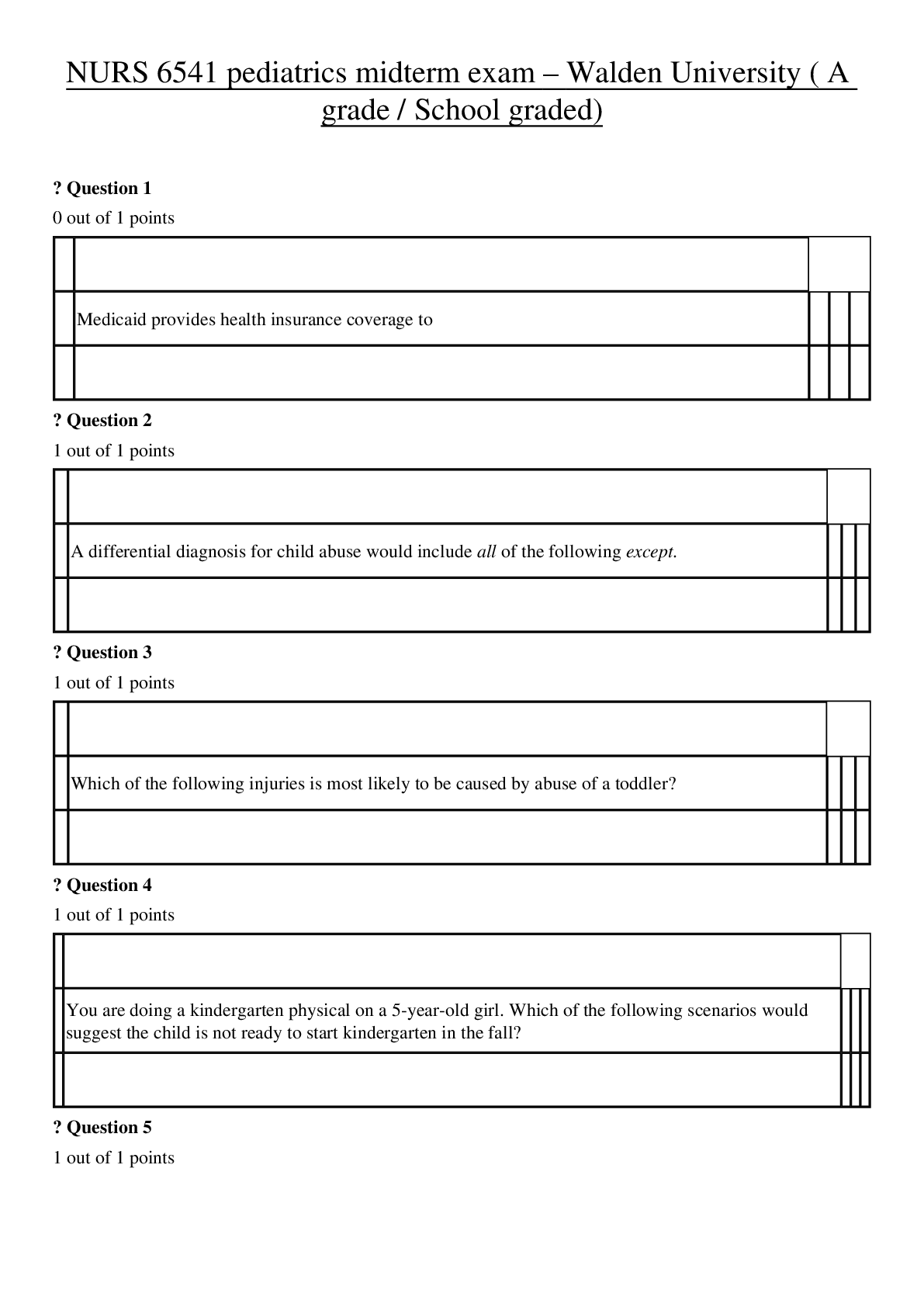
Reviews( 0 )
Document information
Connected school, study & course
About the document
Uploaded On
May 18, 2020
Number of pages
41
Written in
Additional information
This document has been written for:
Uploaded
May 18, 2020
Downloads
0
Views
100


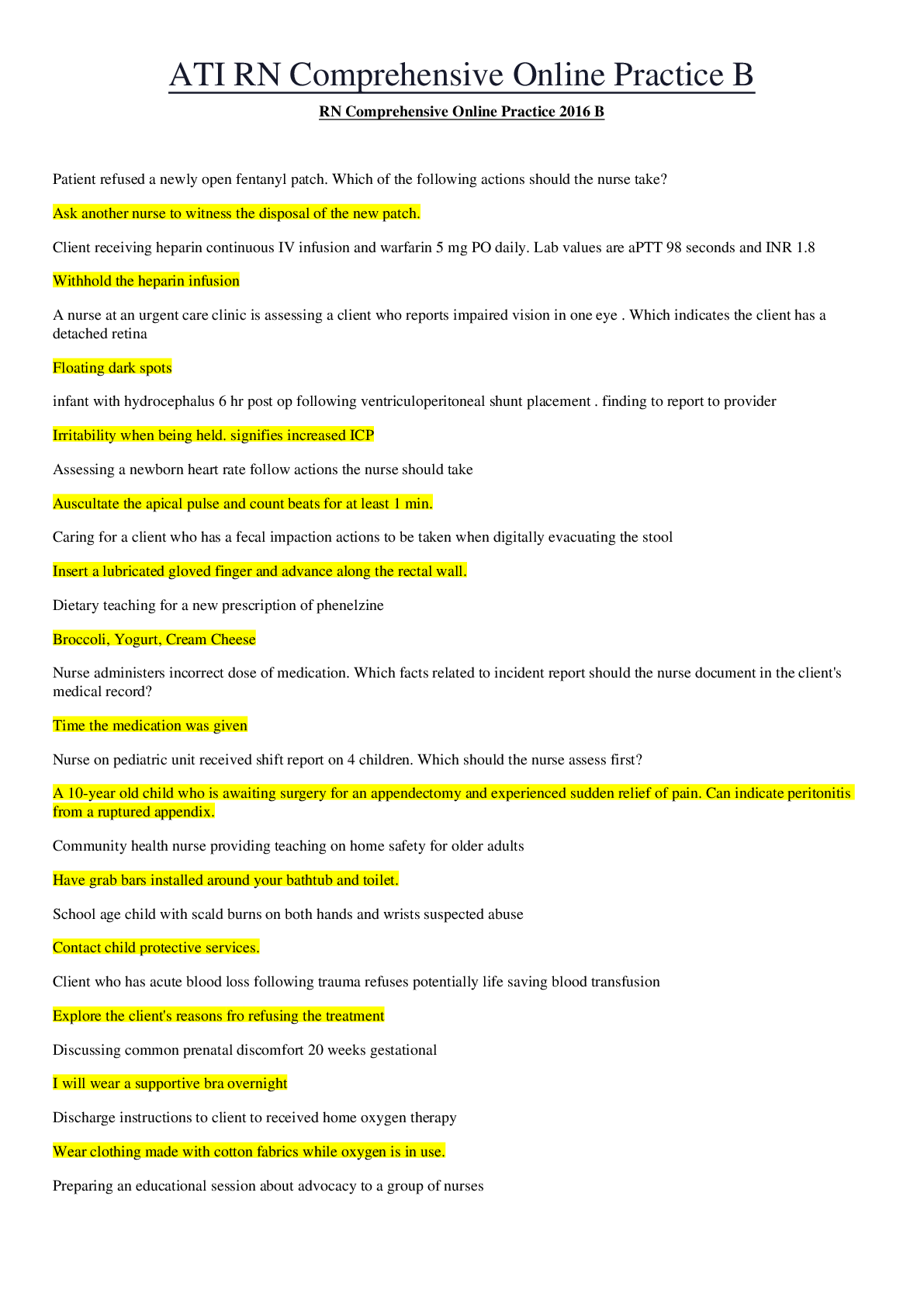
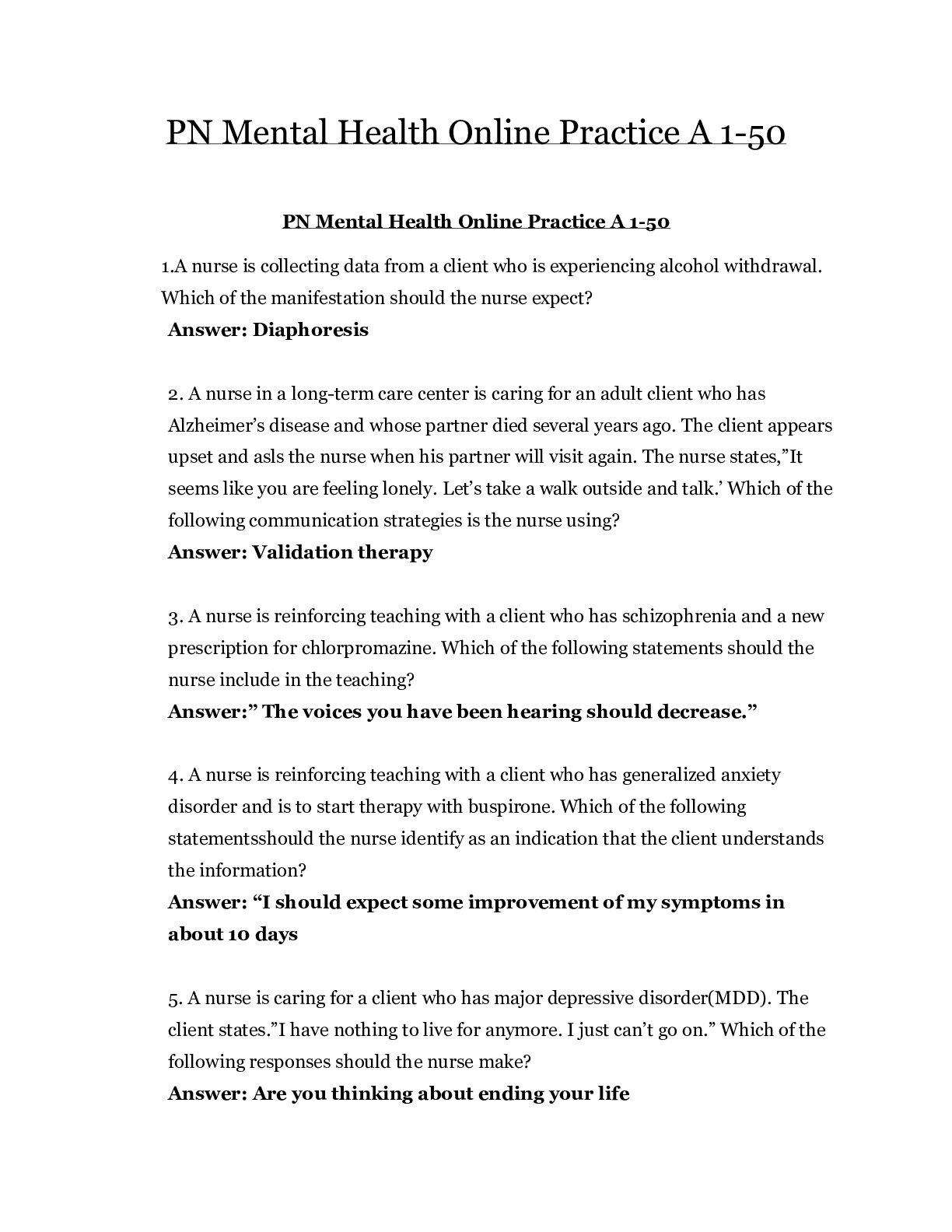
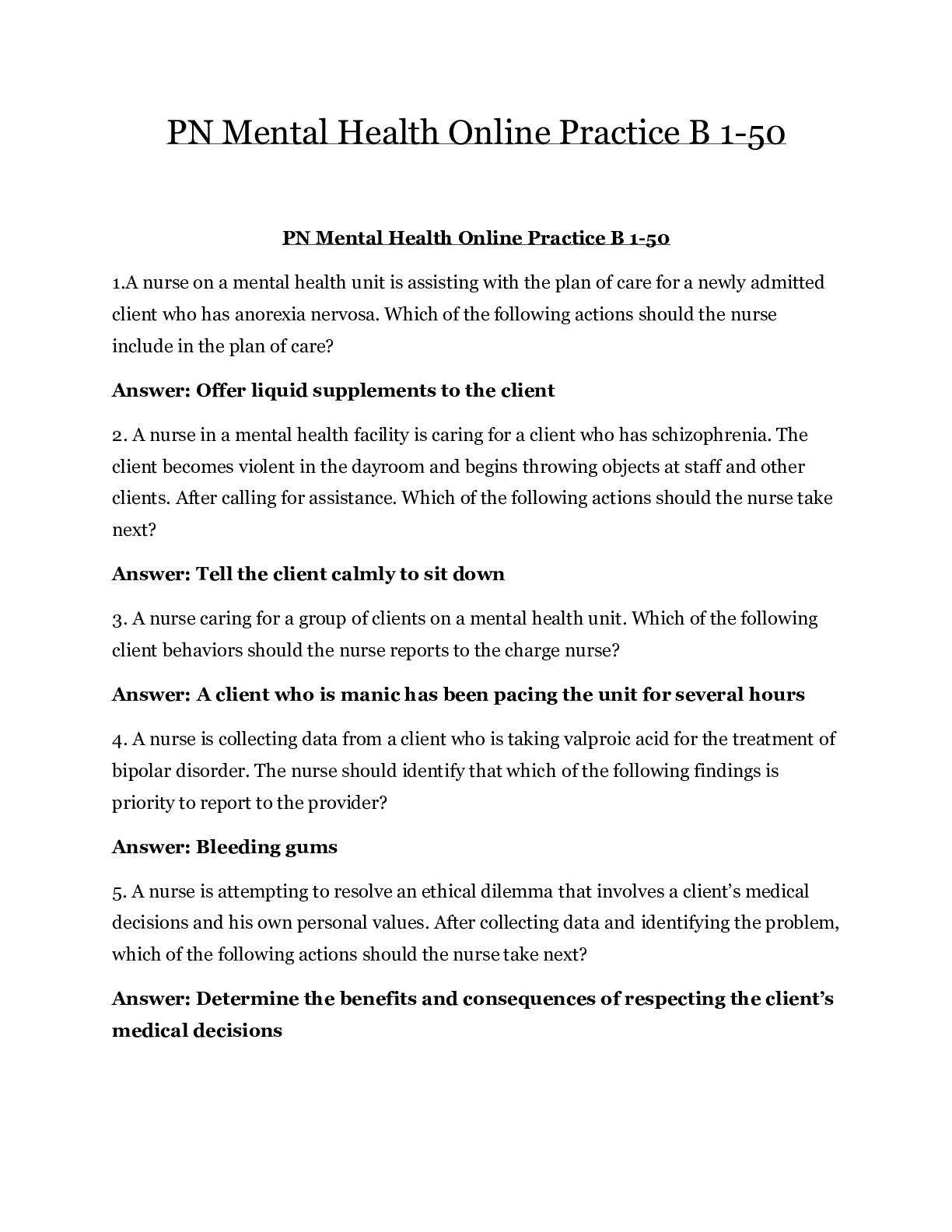
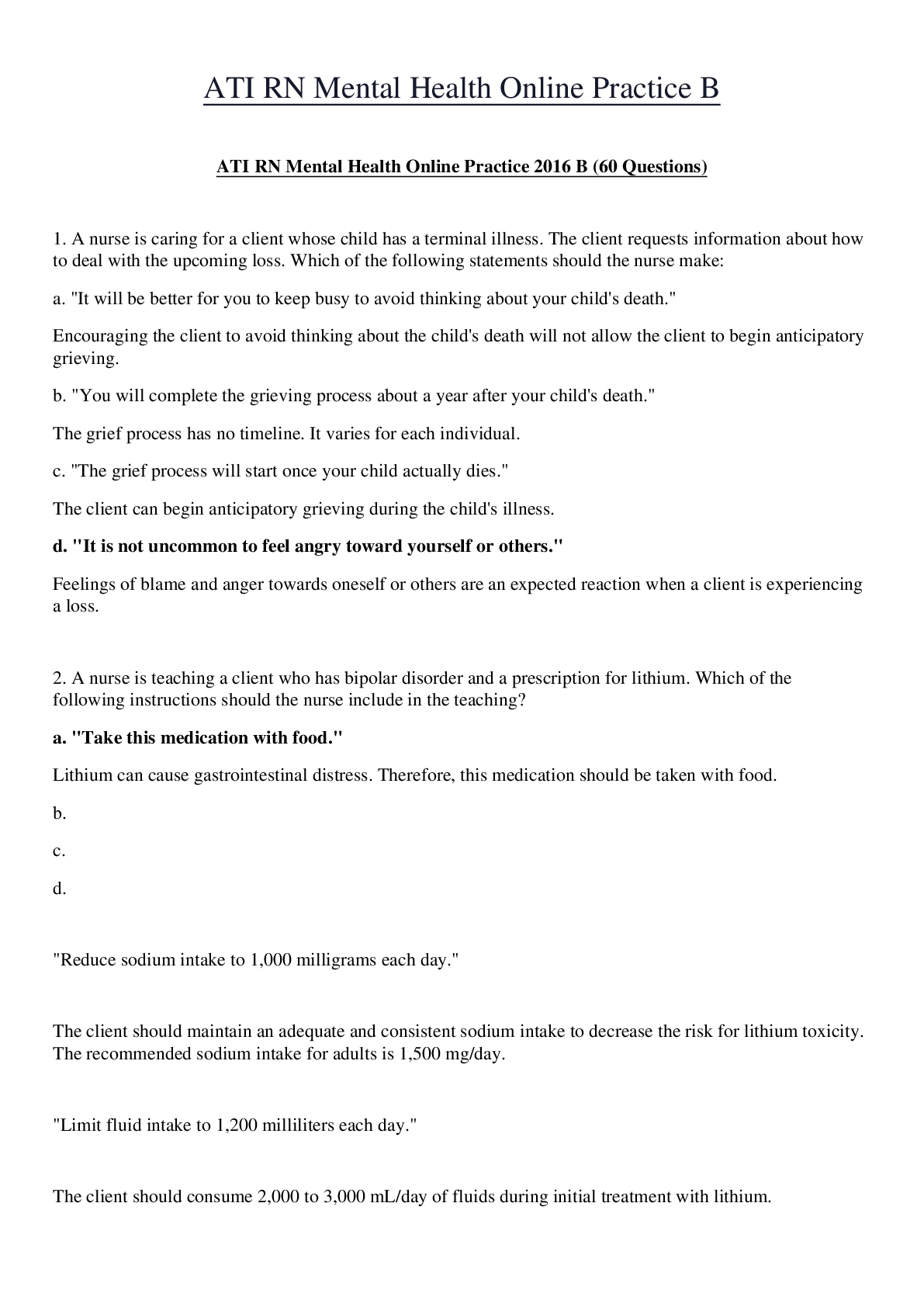


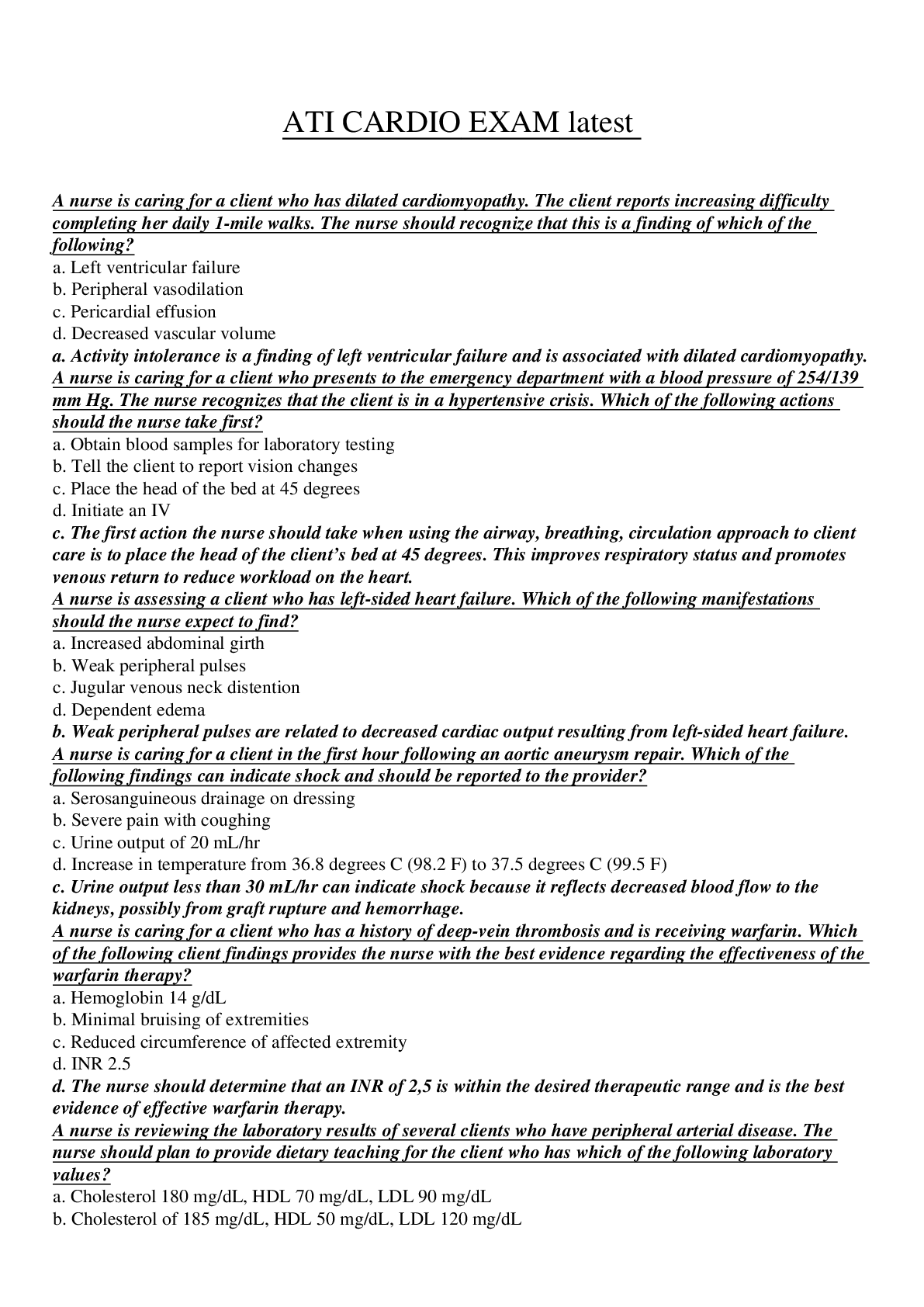
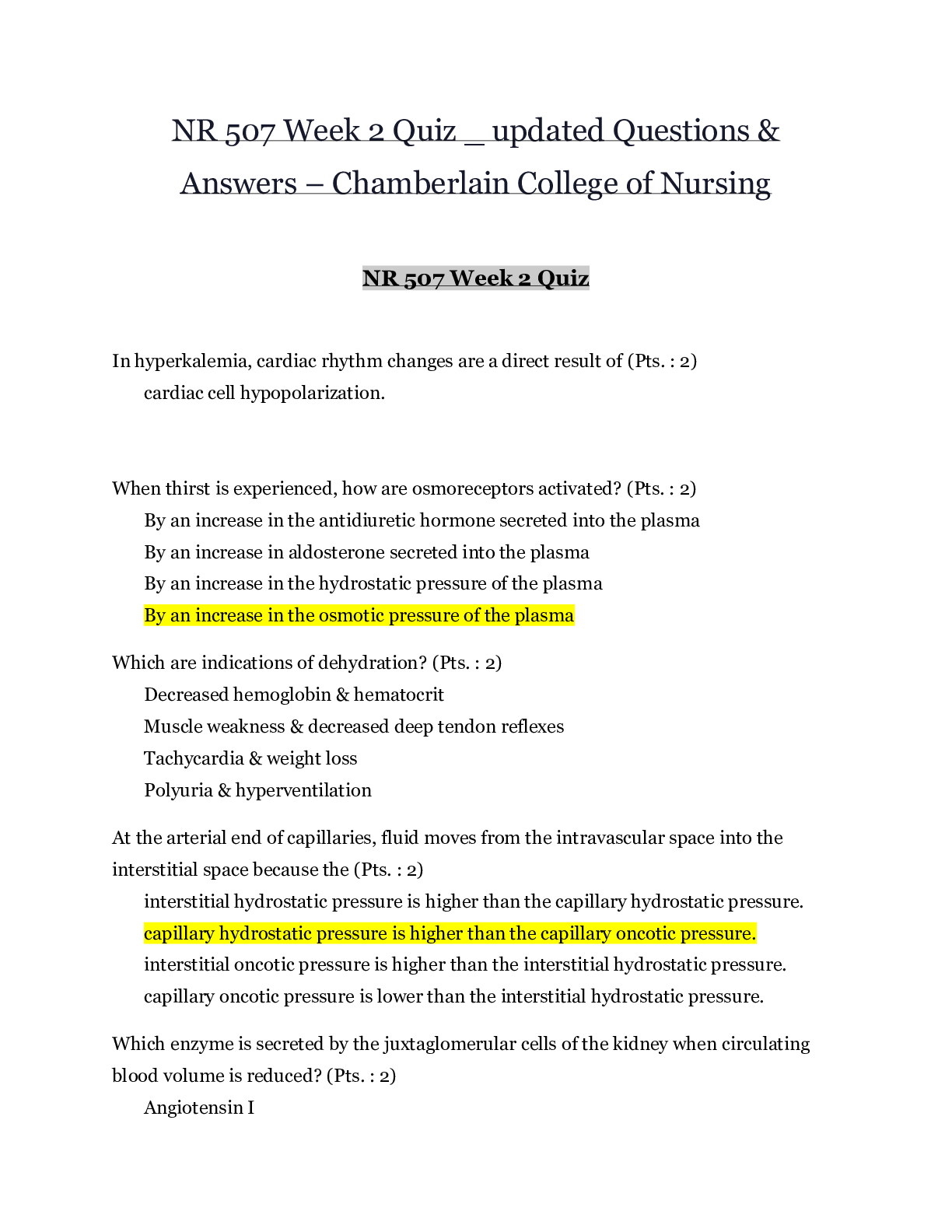
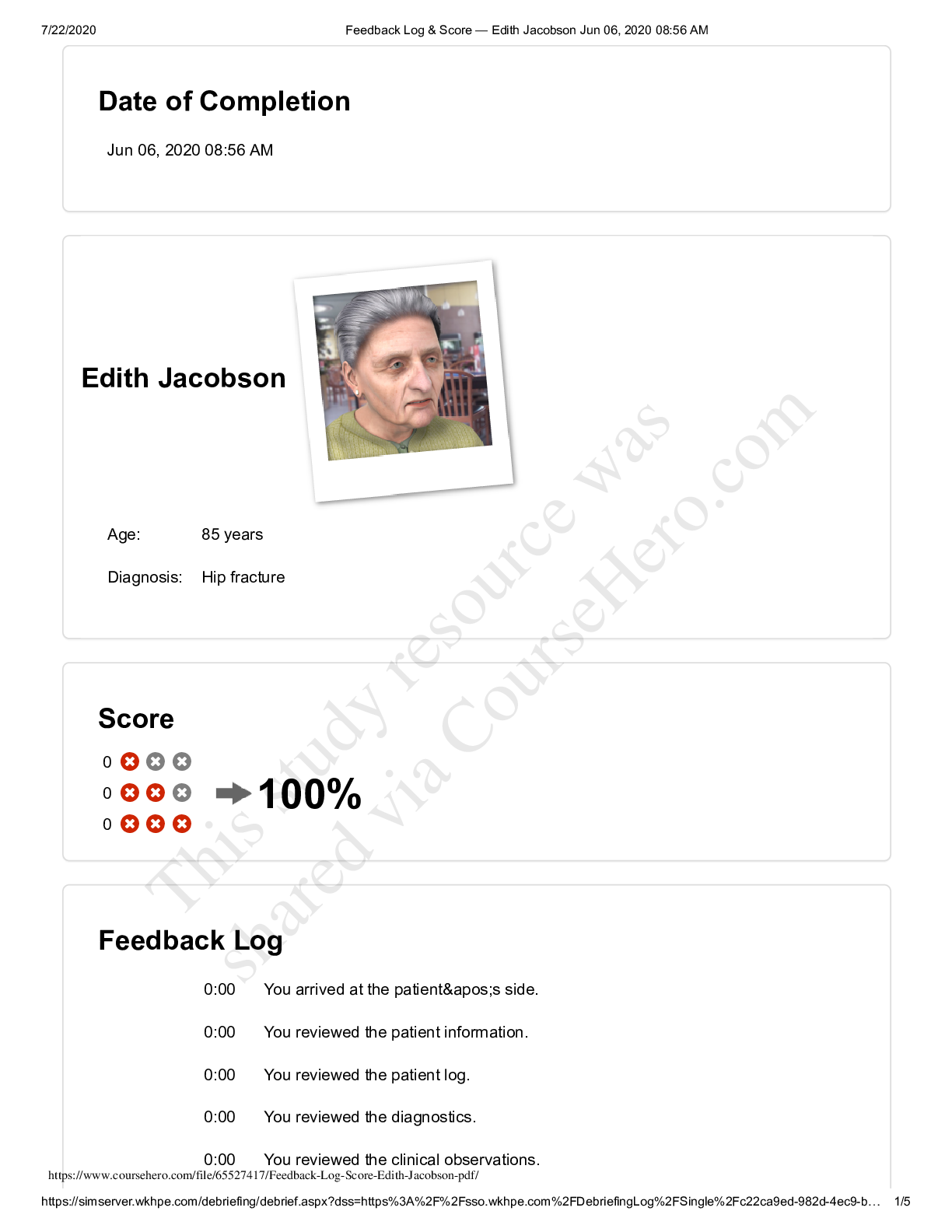
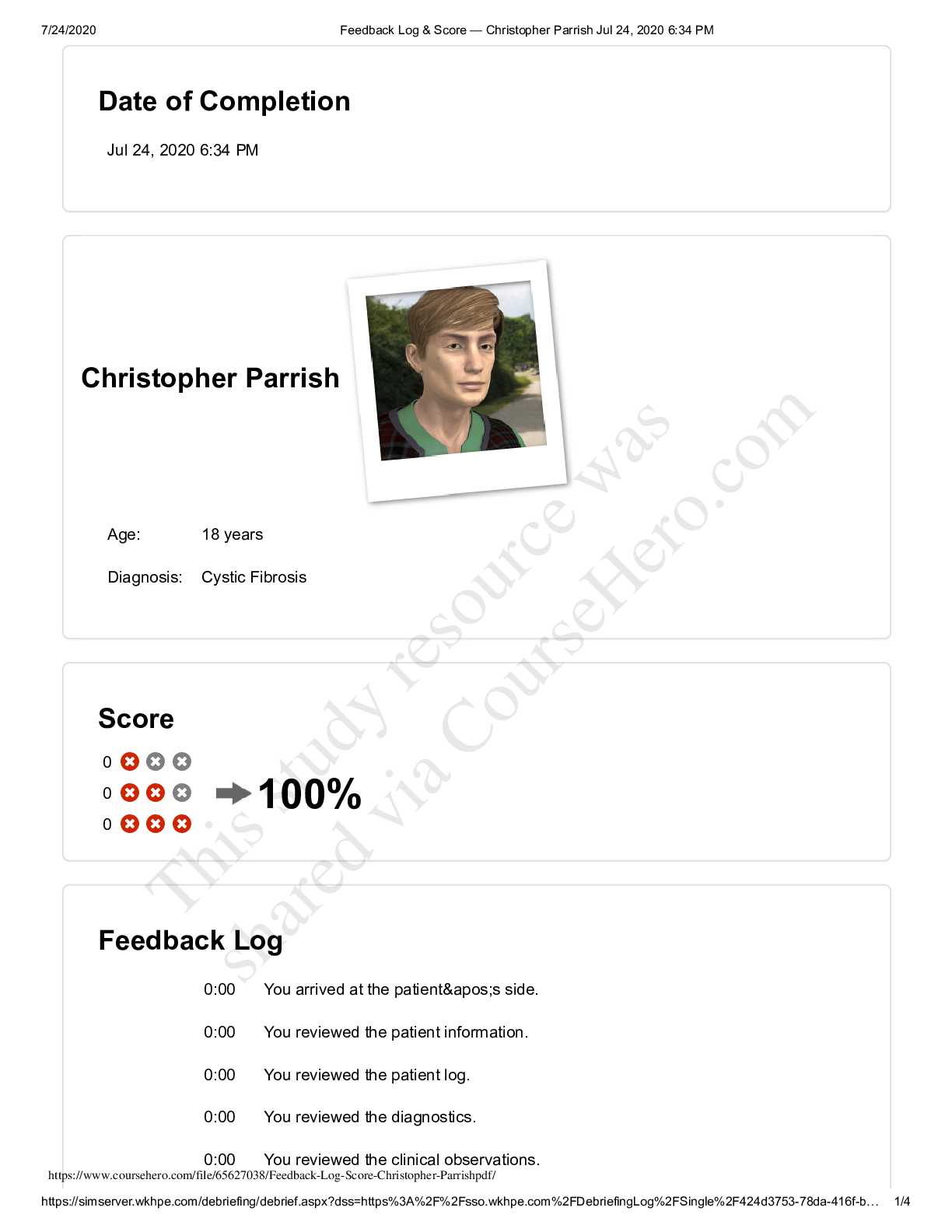
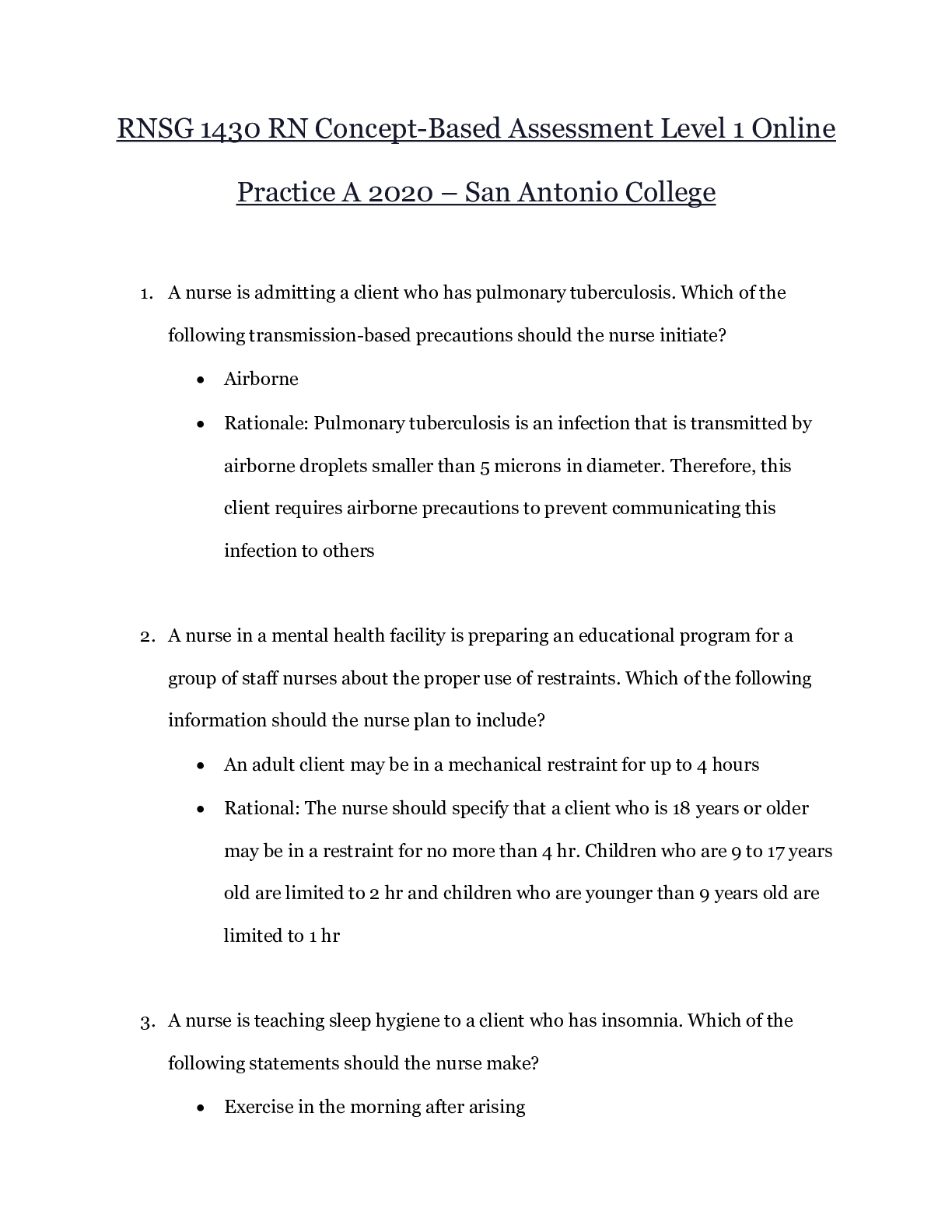


 – CHAMBERLAIN COLLEGE OF NURSING.png)
